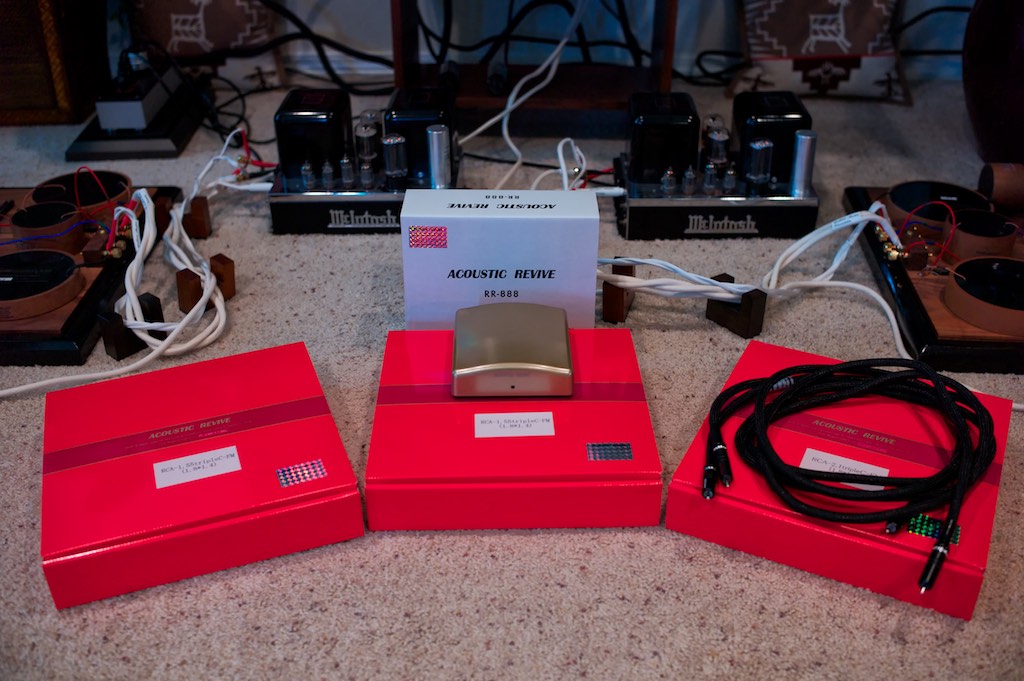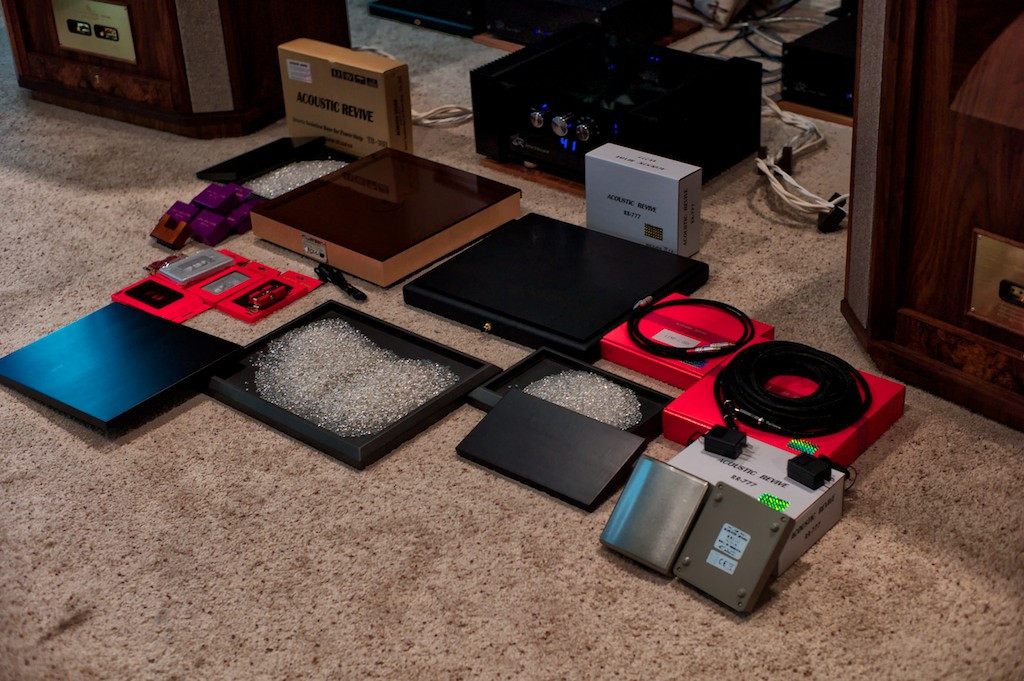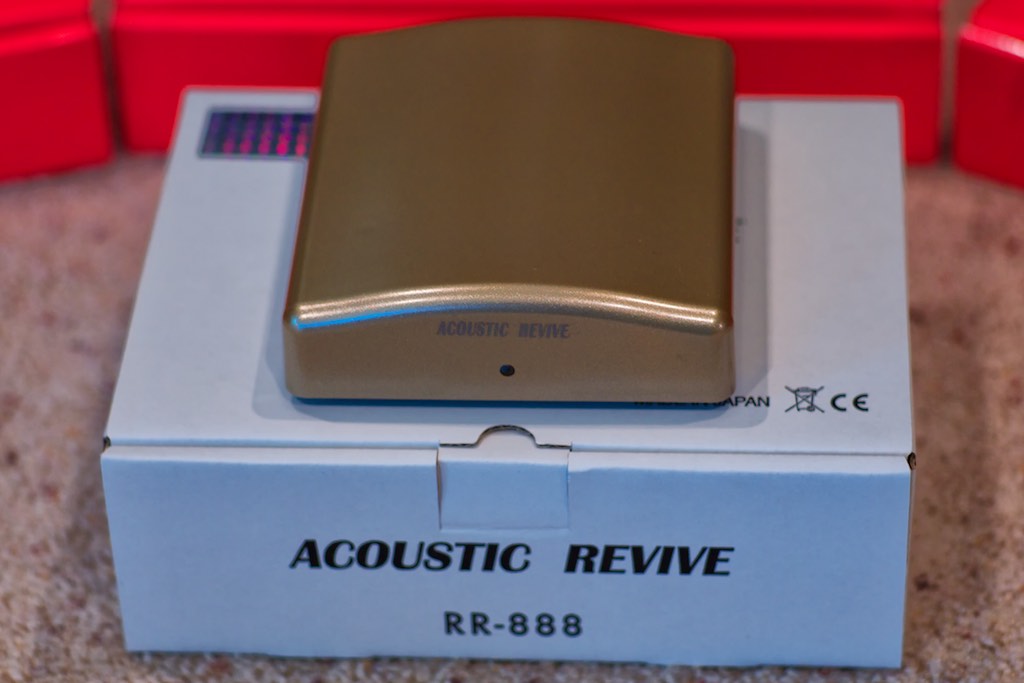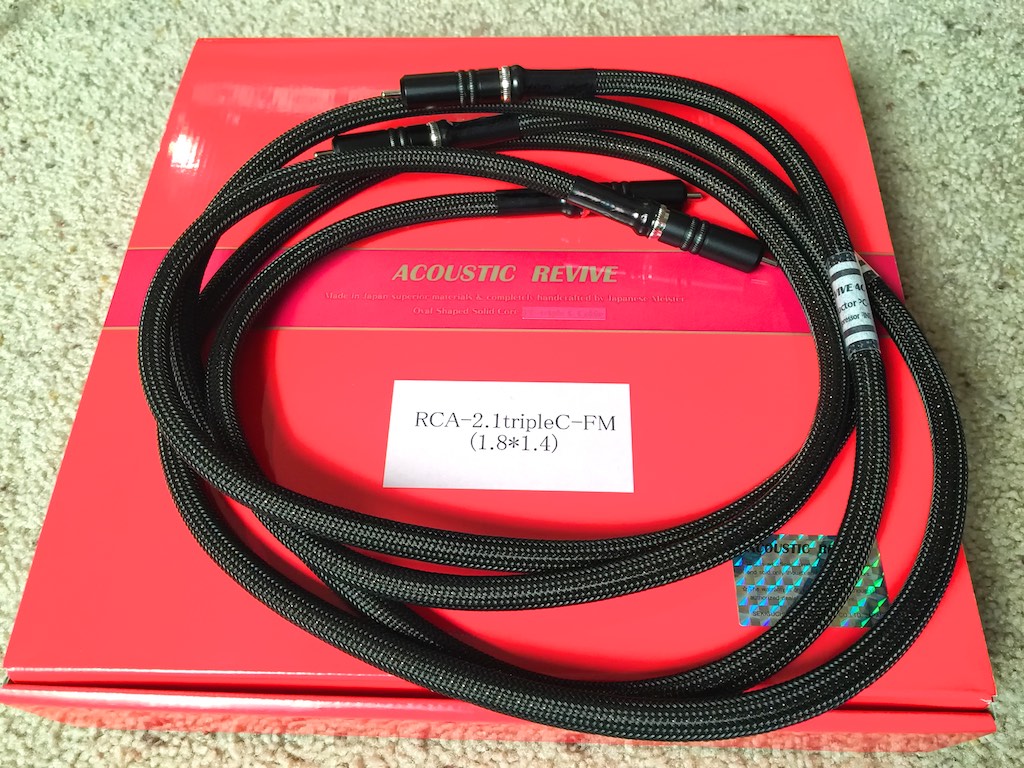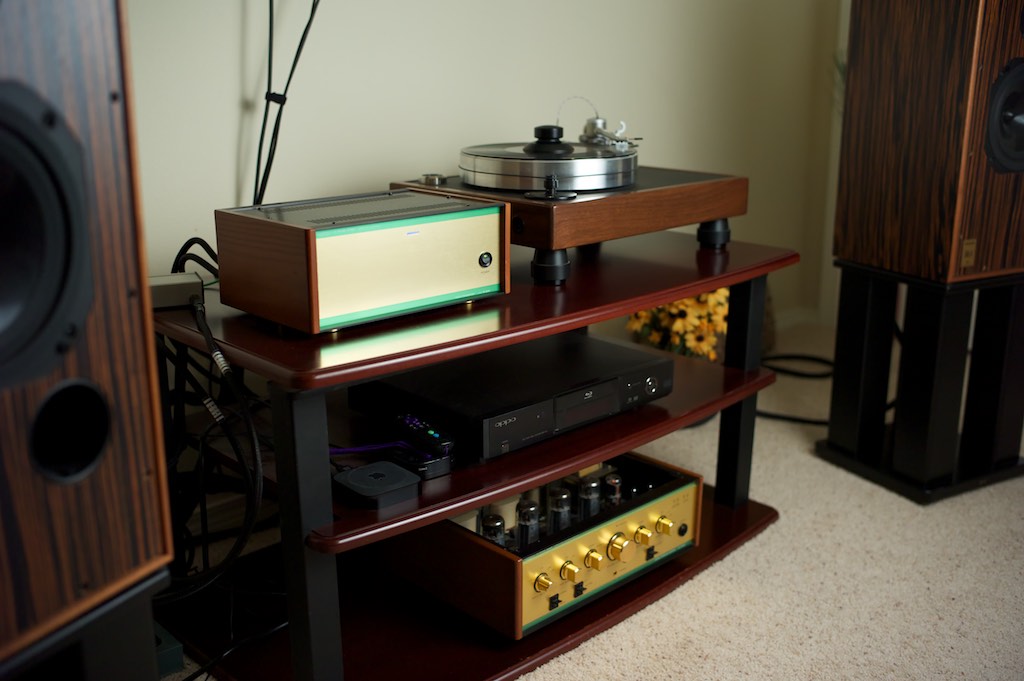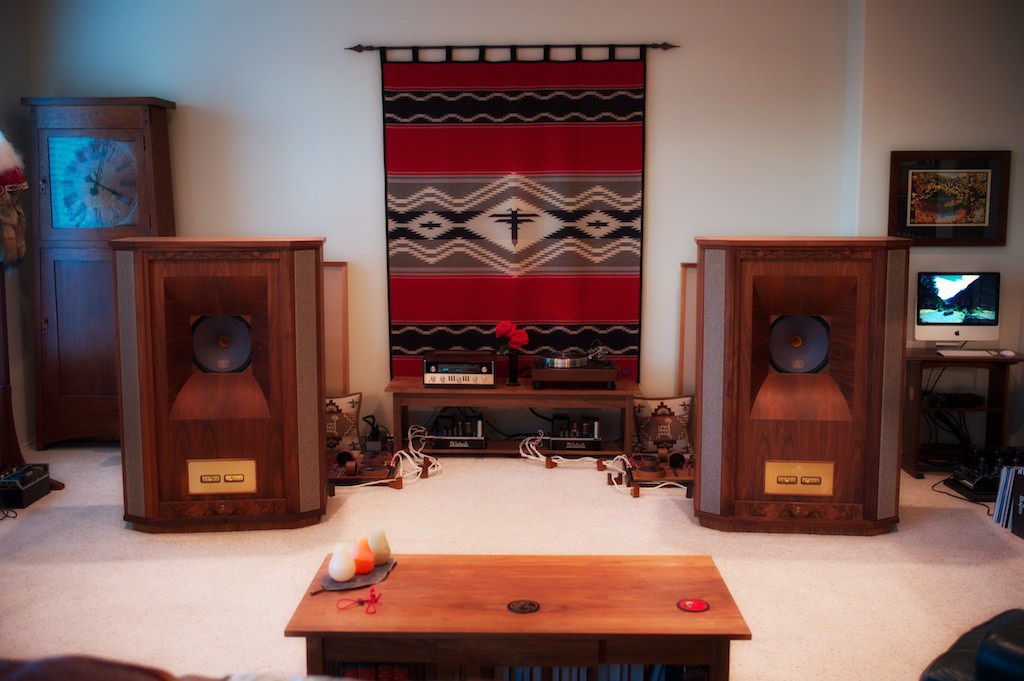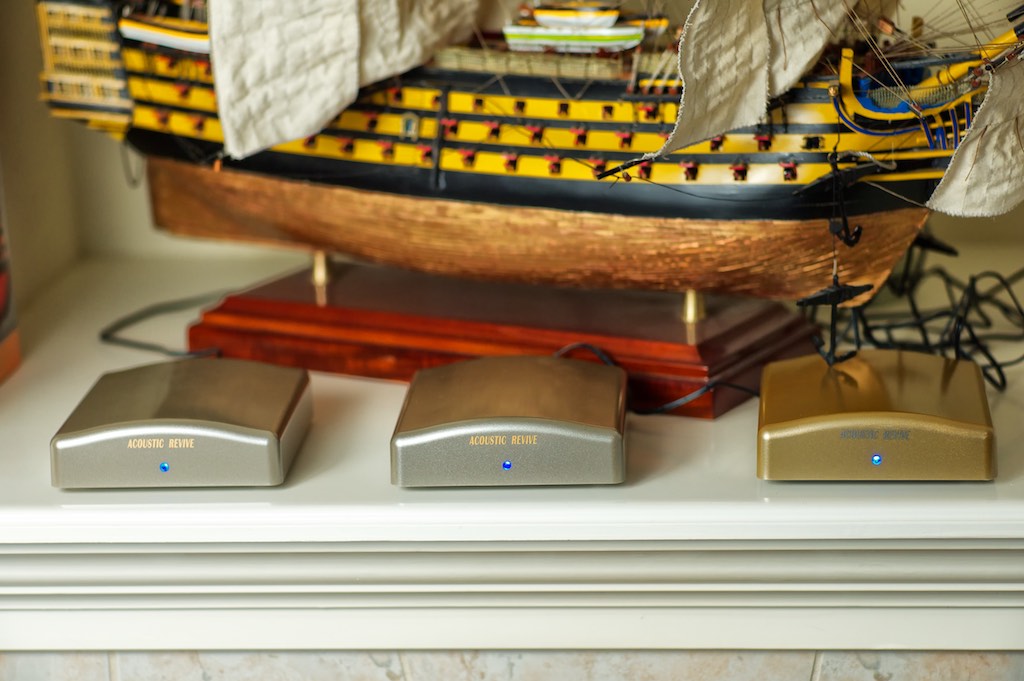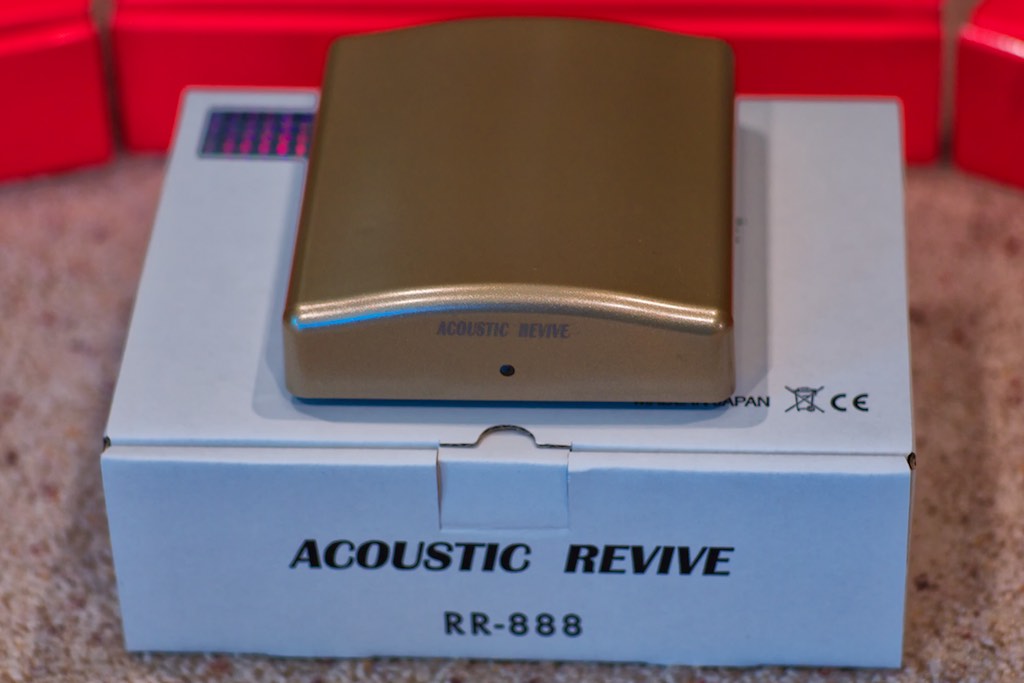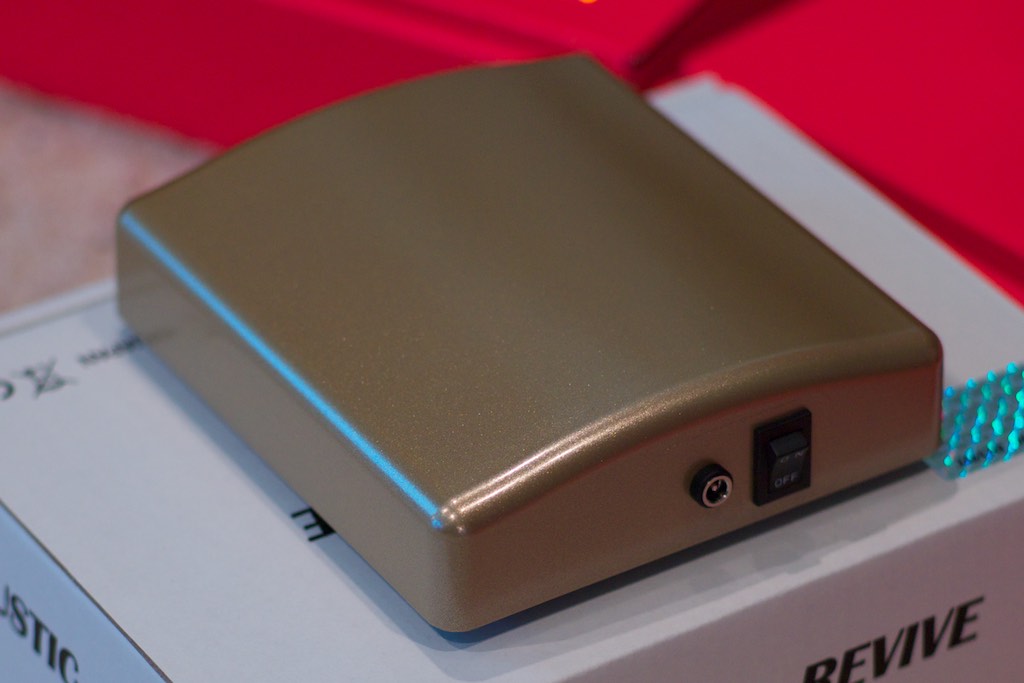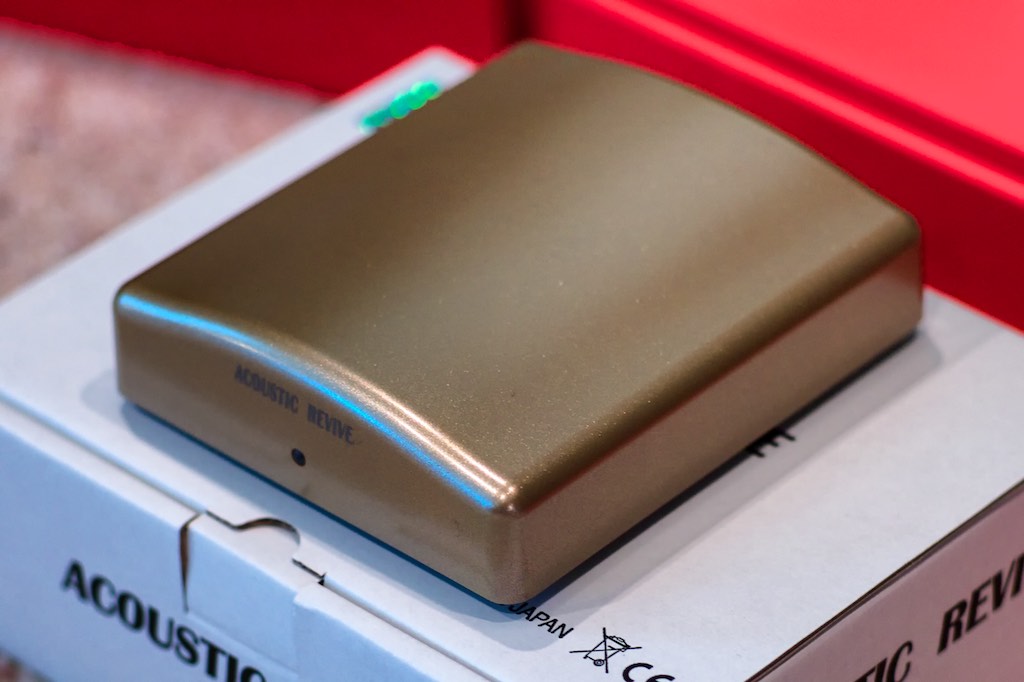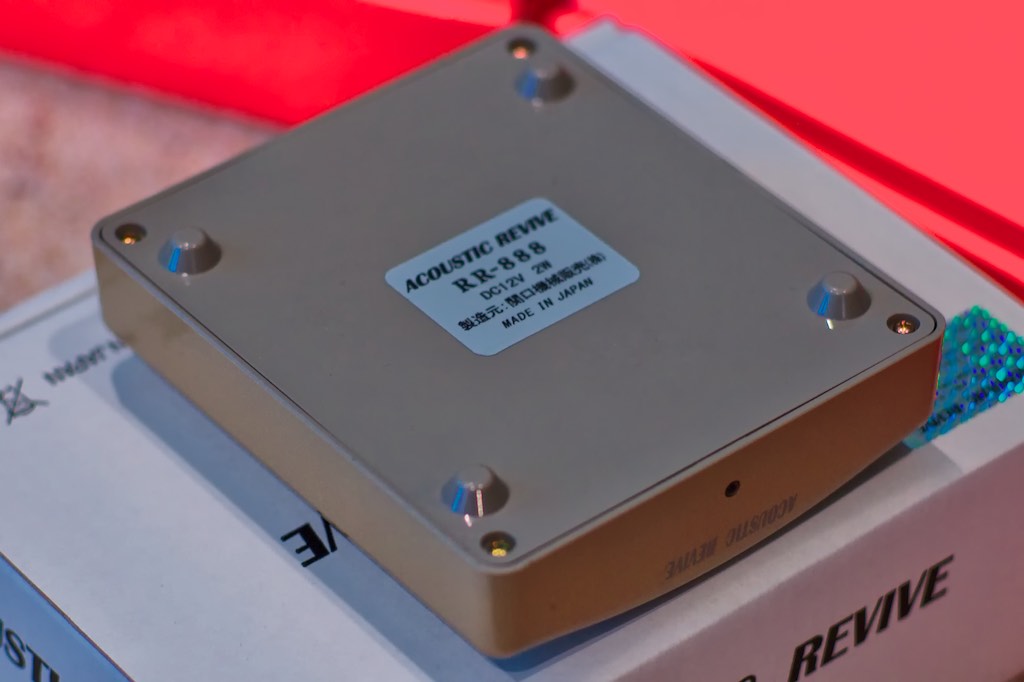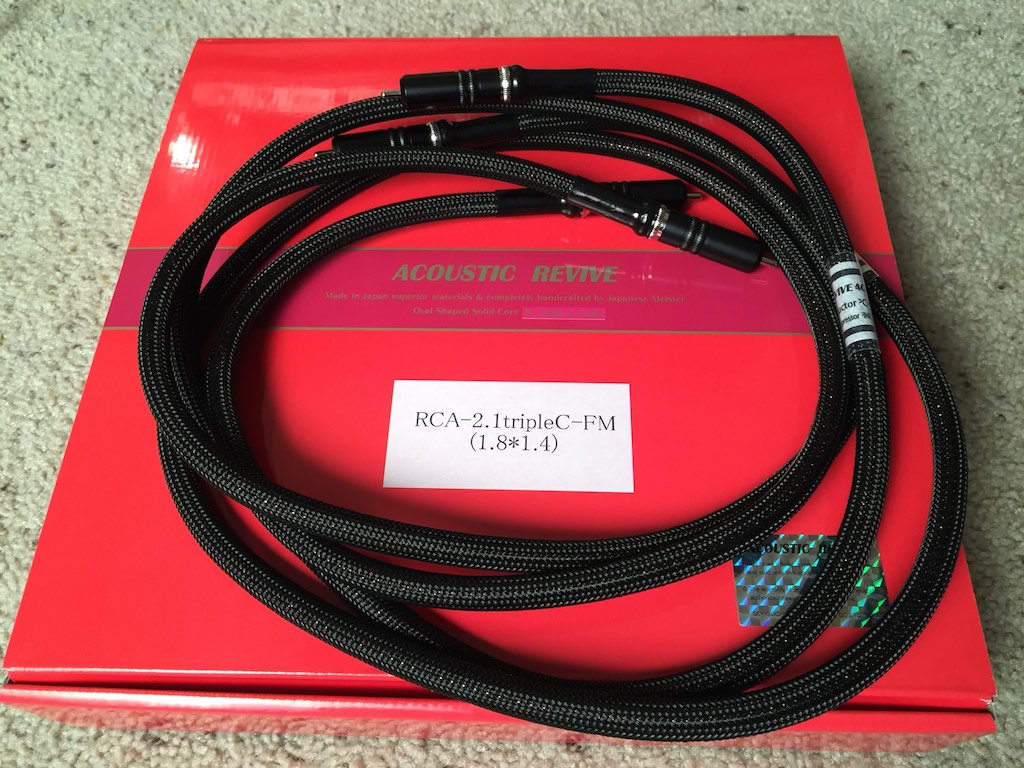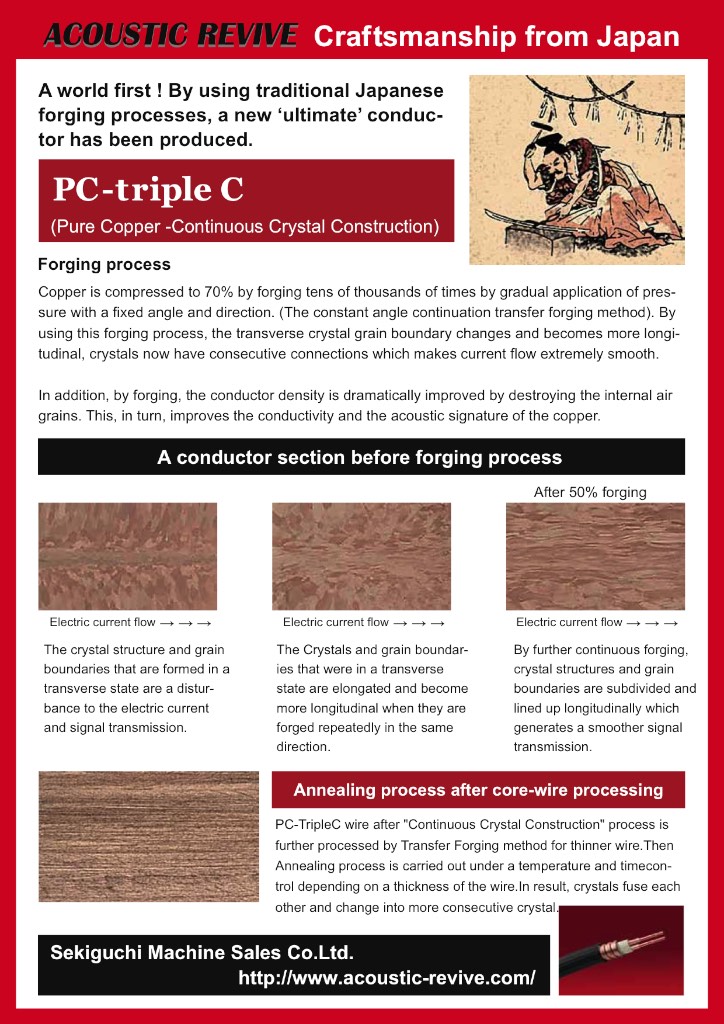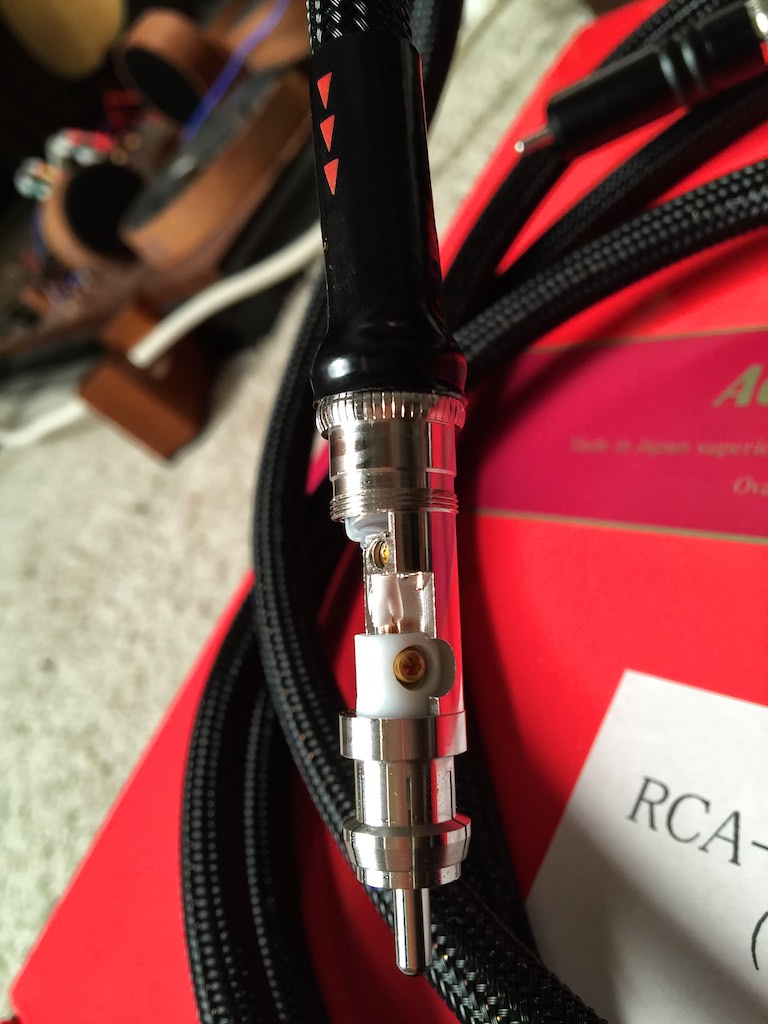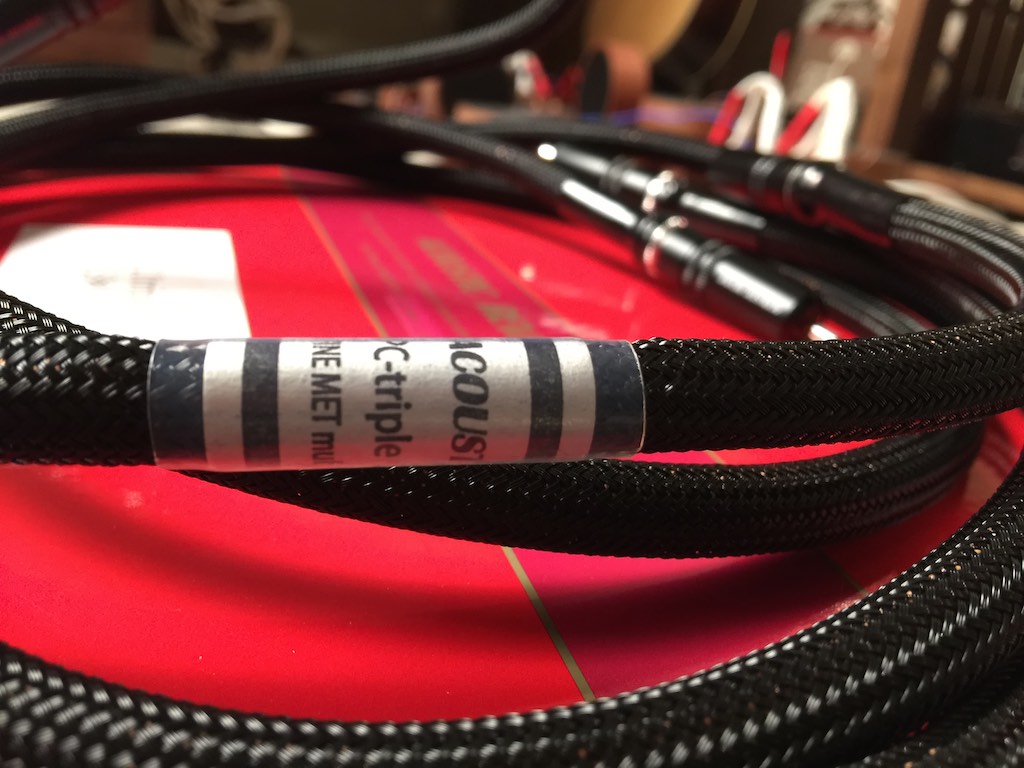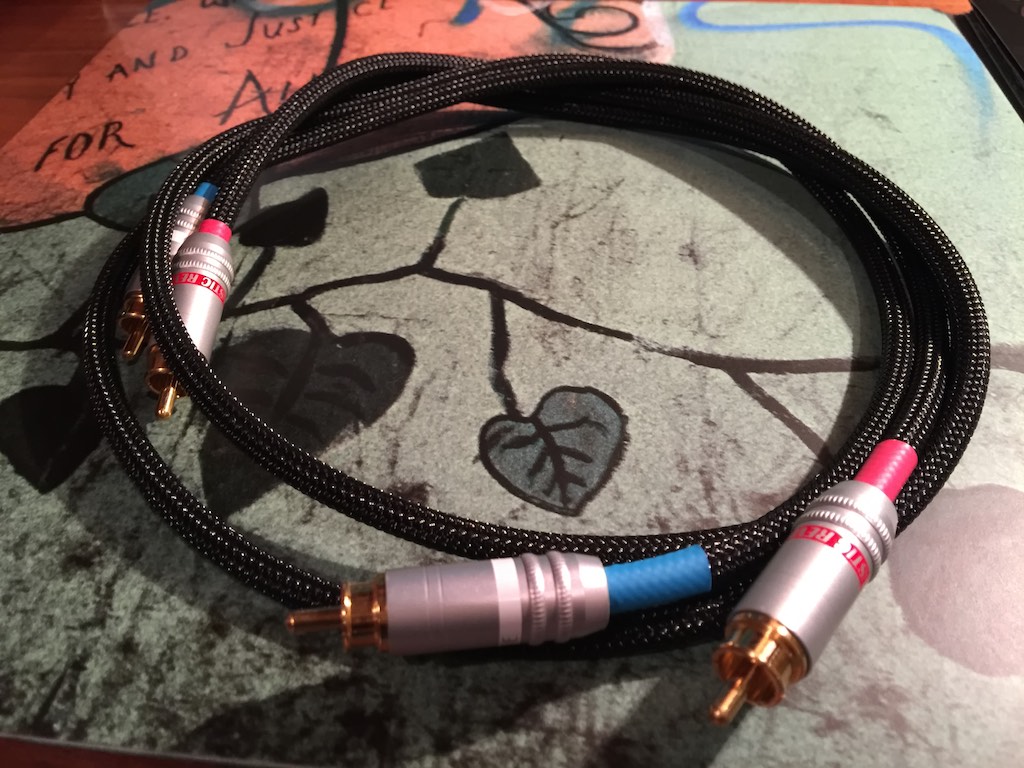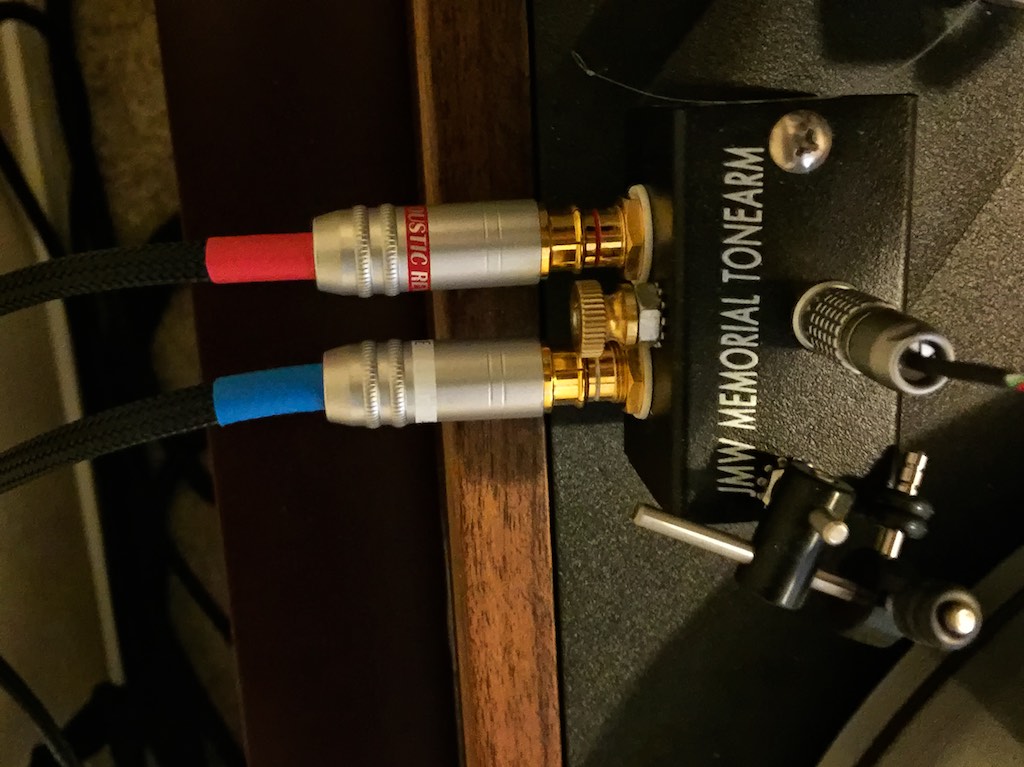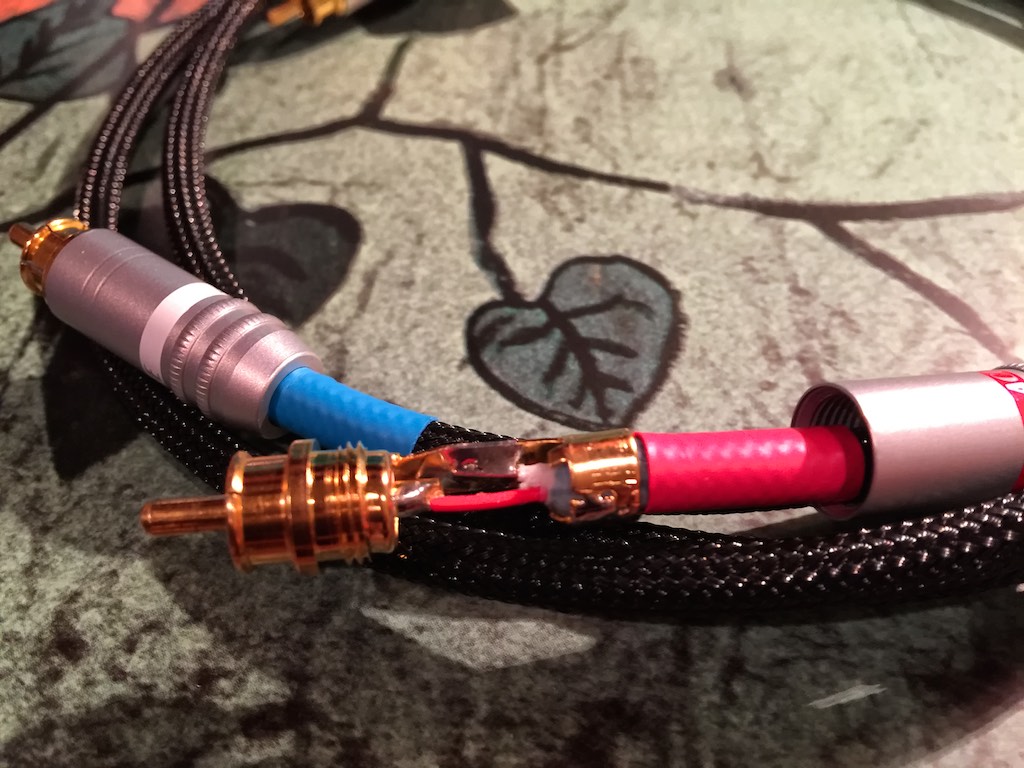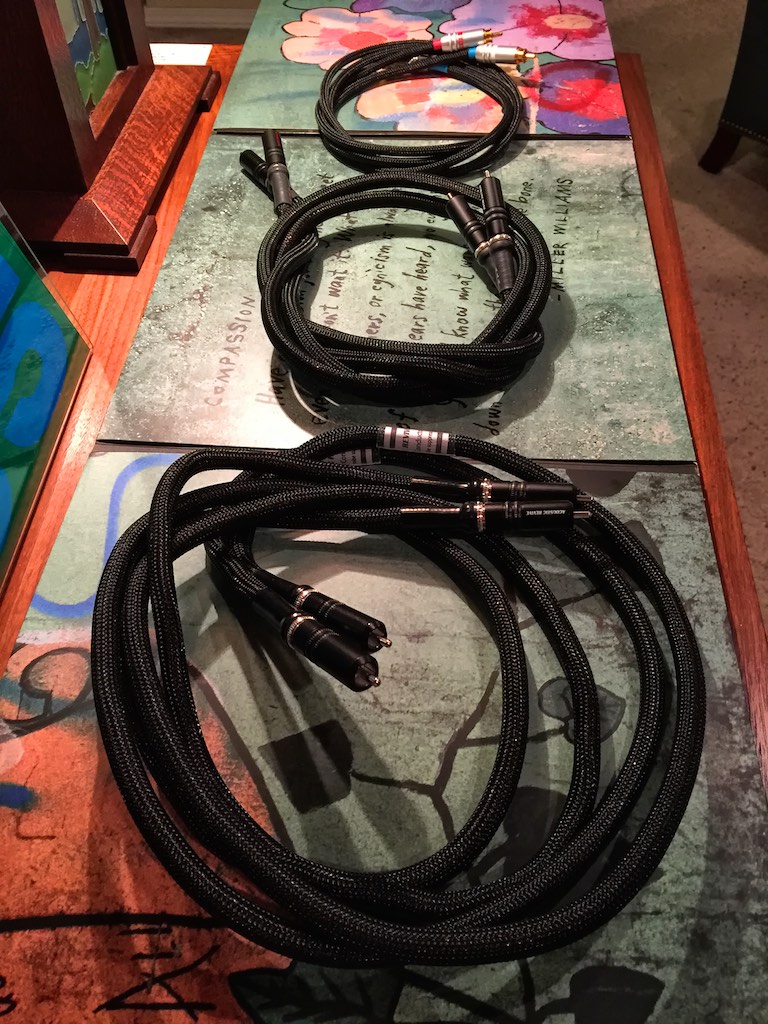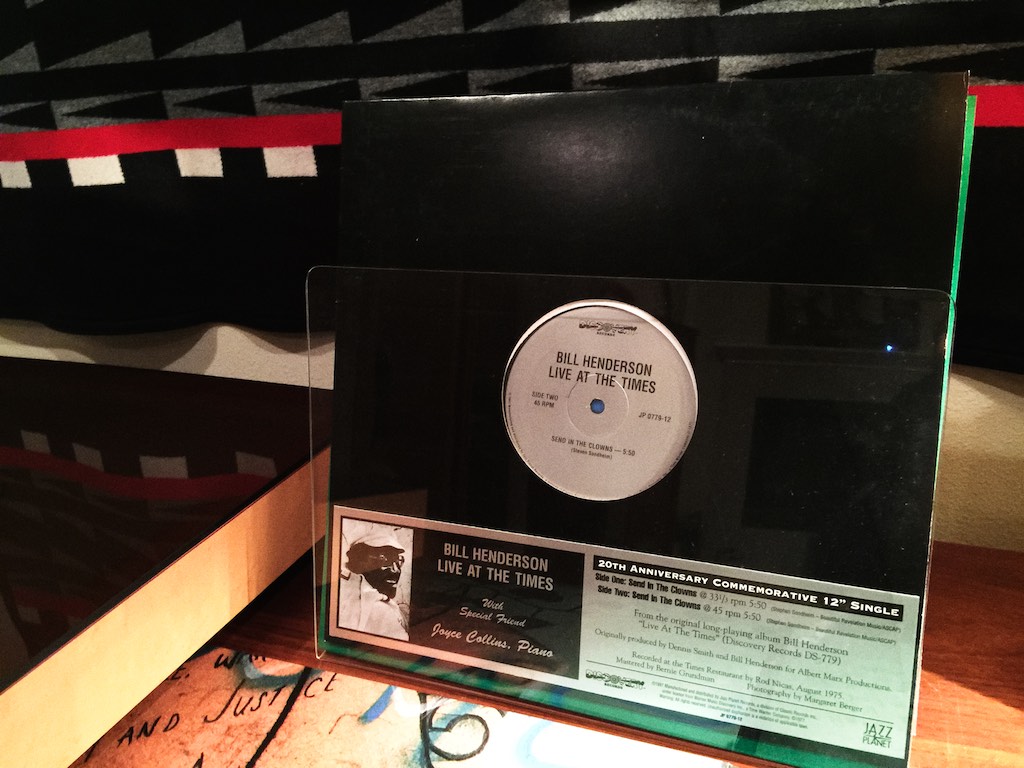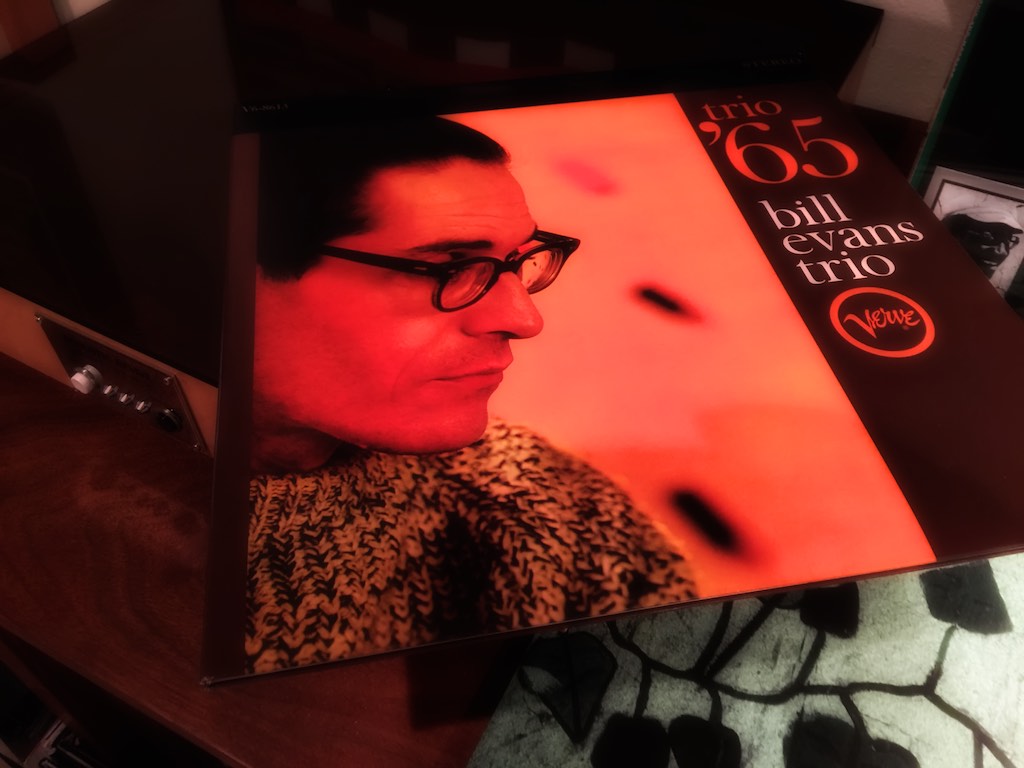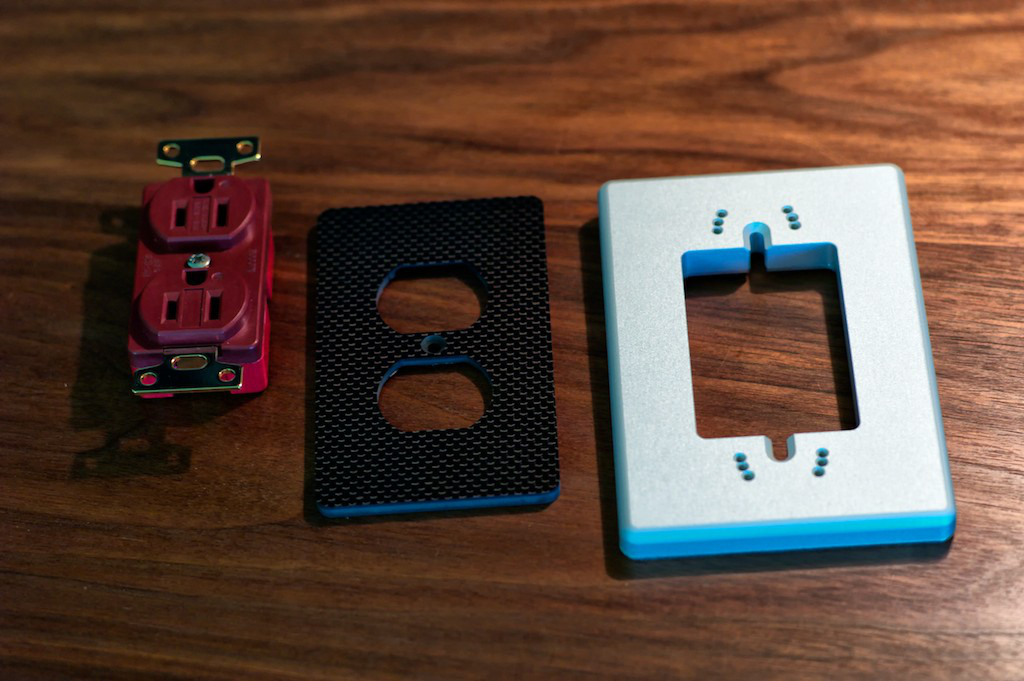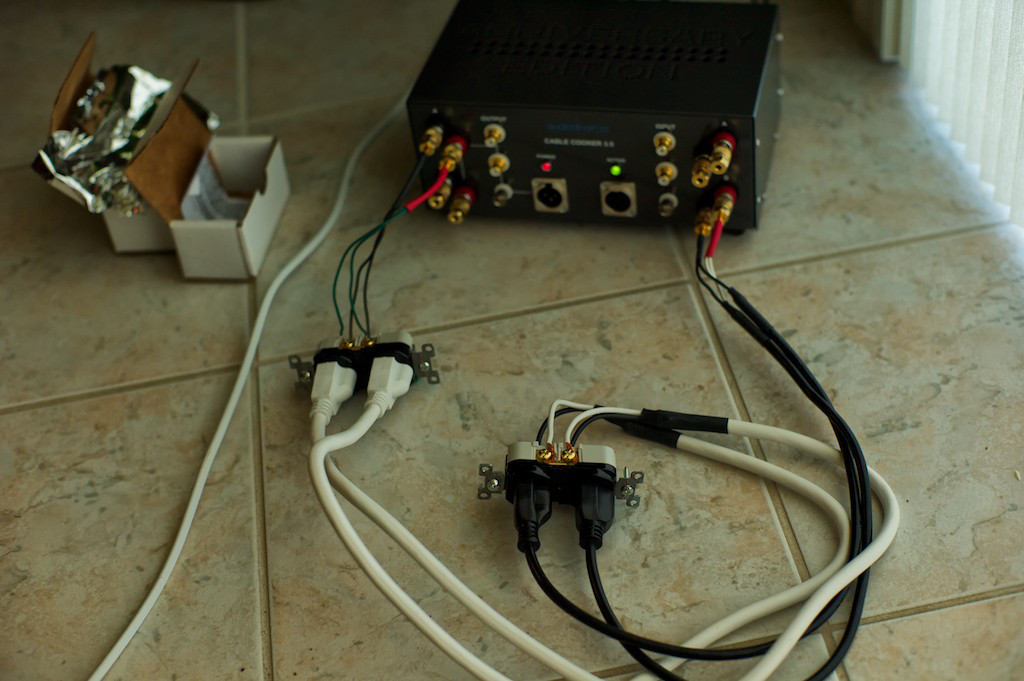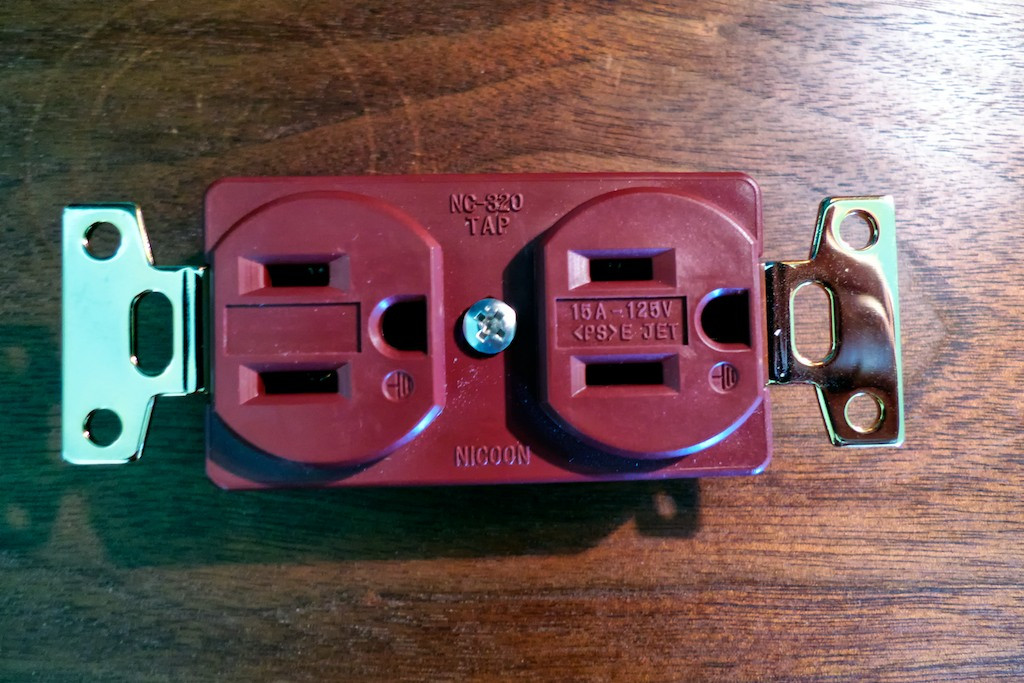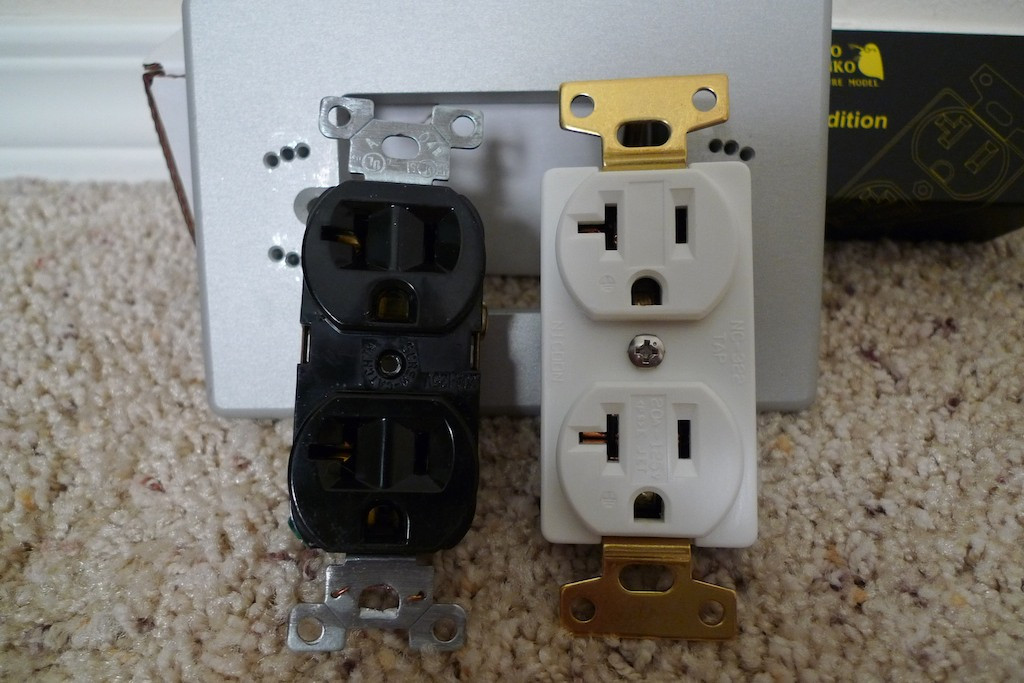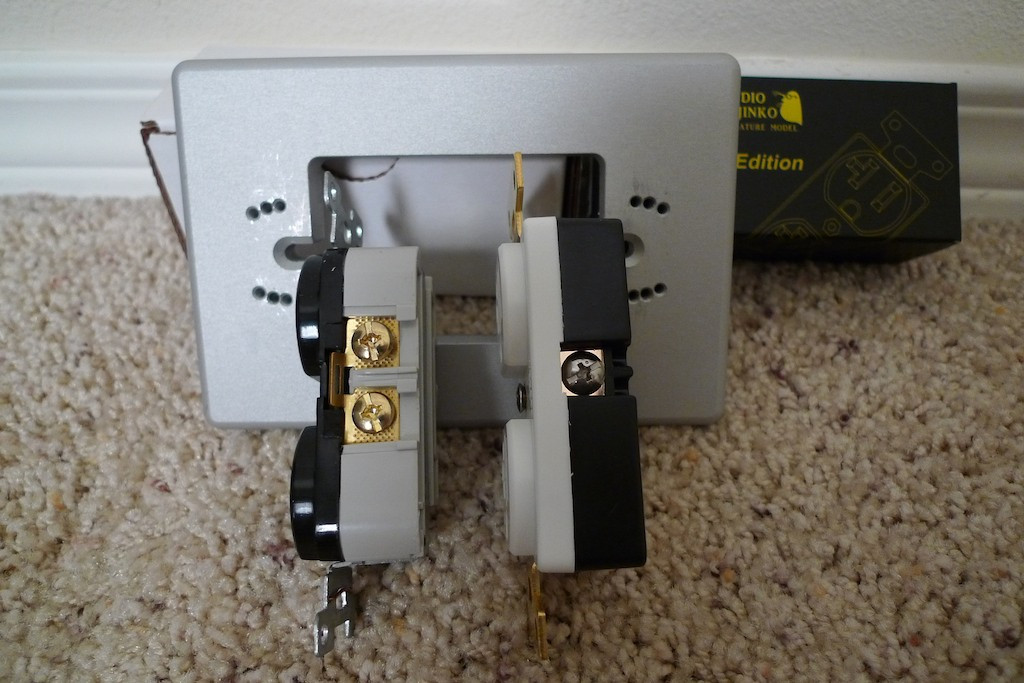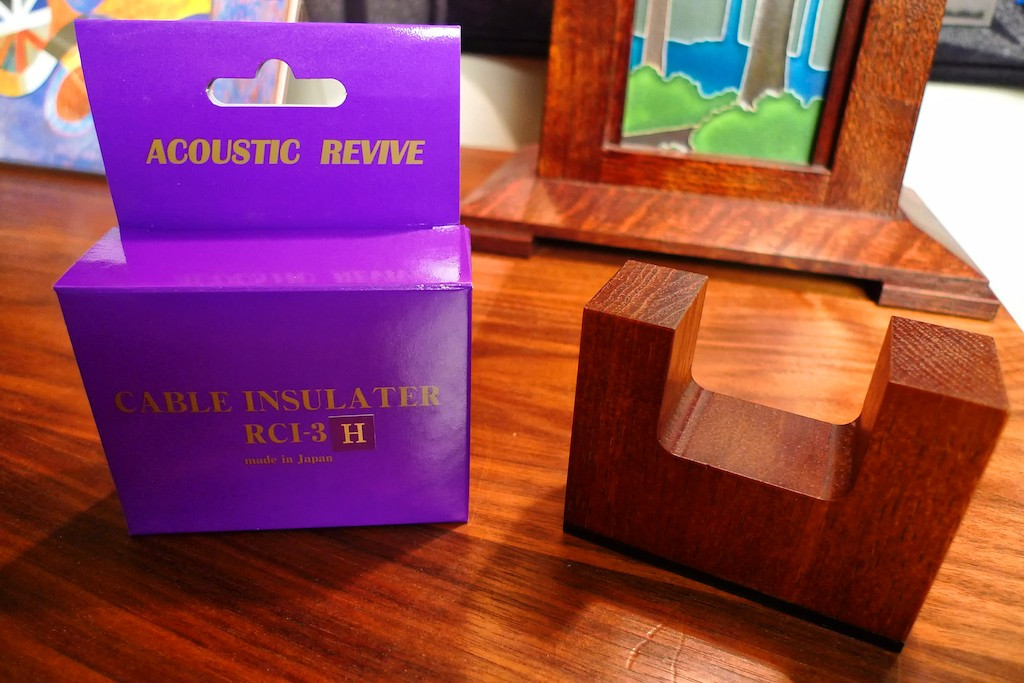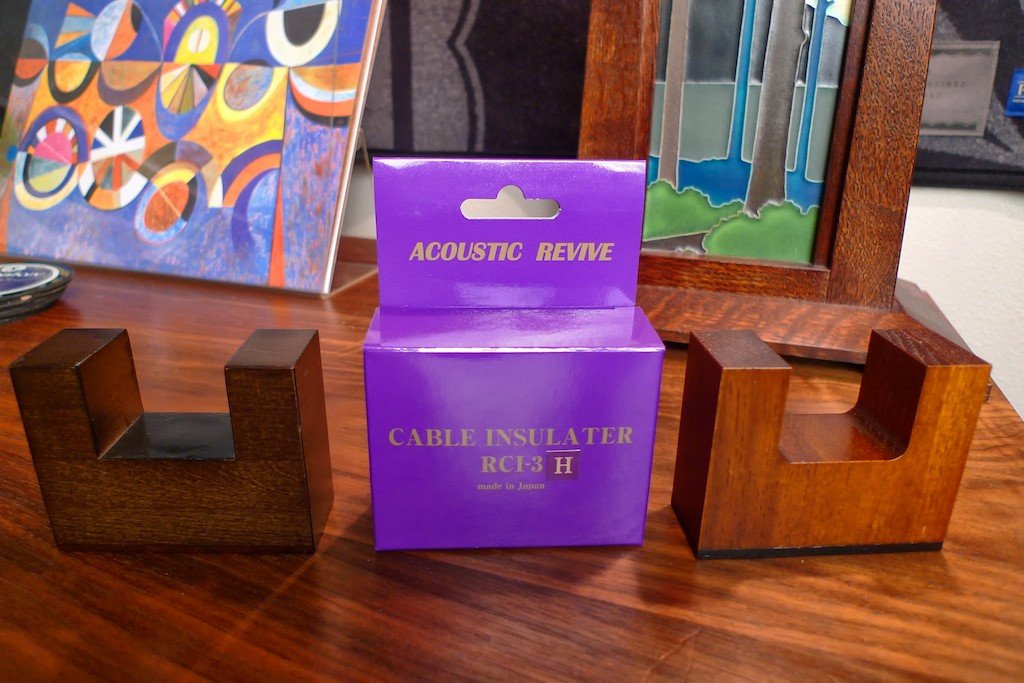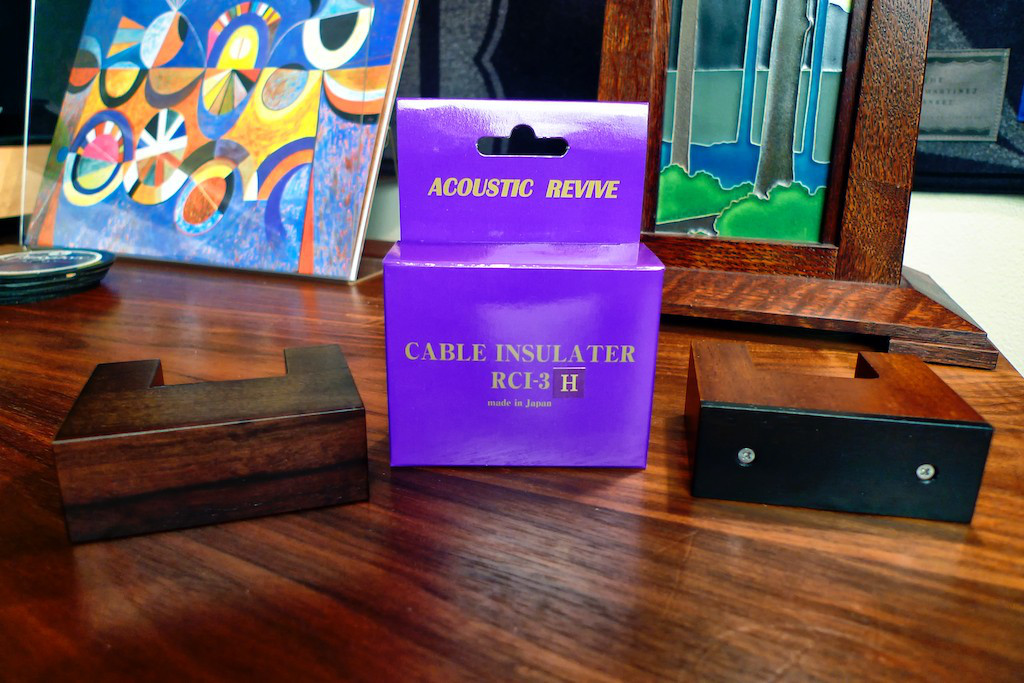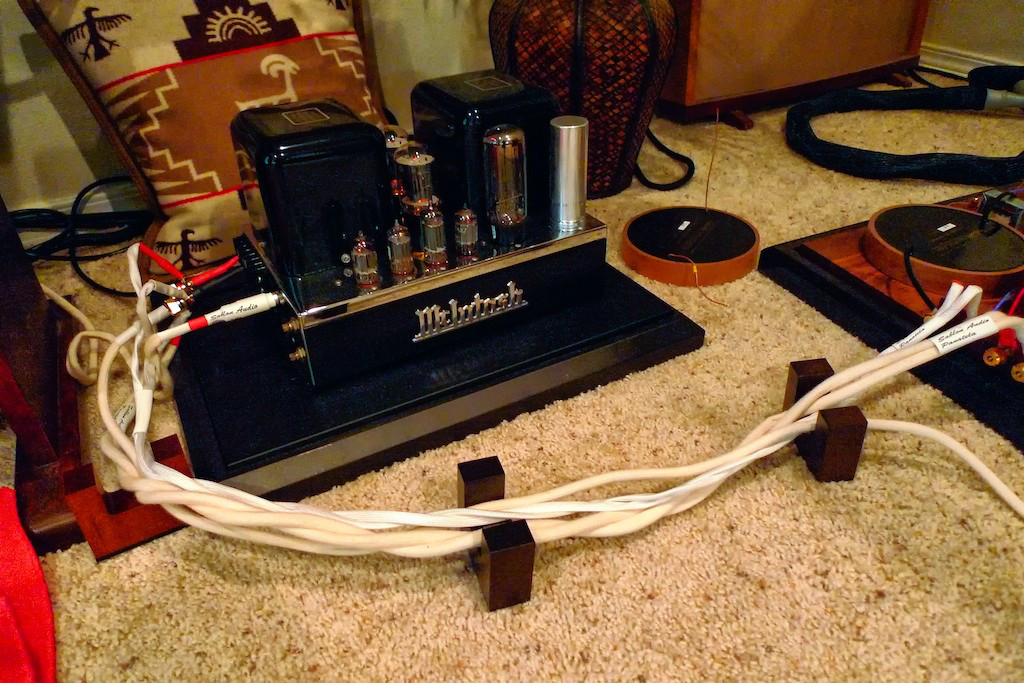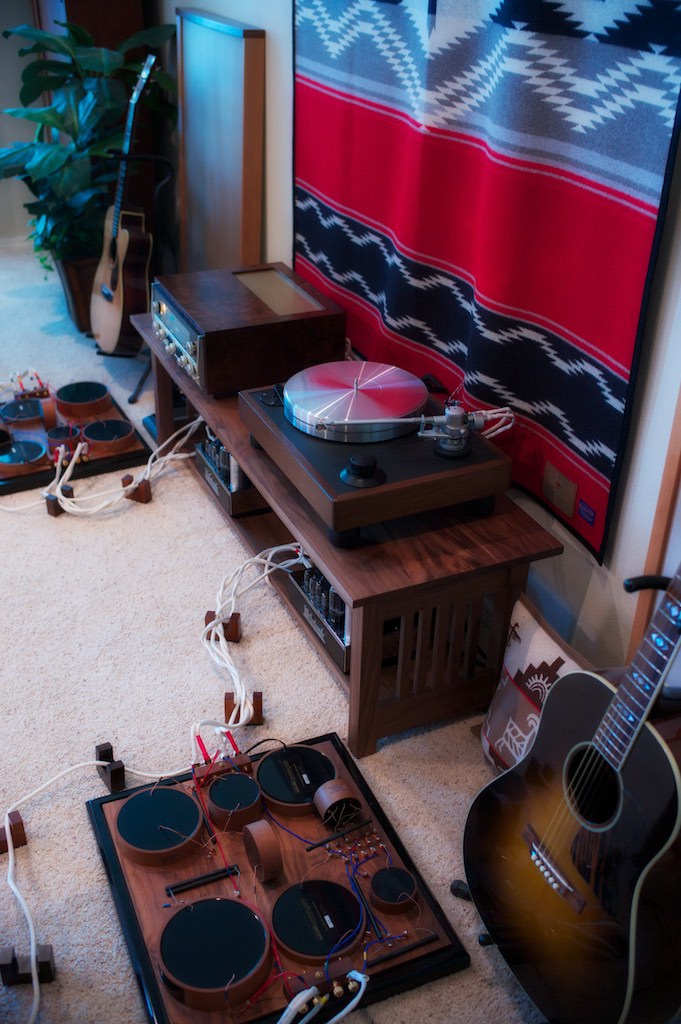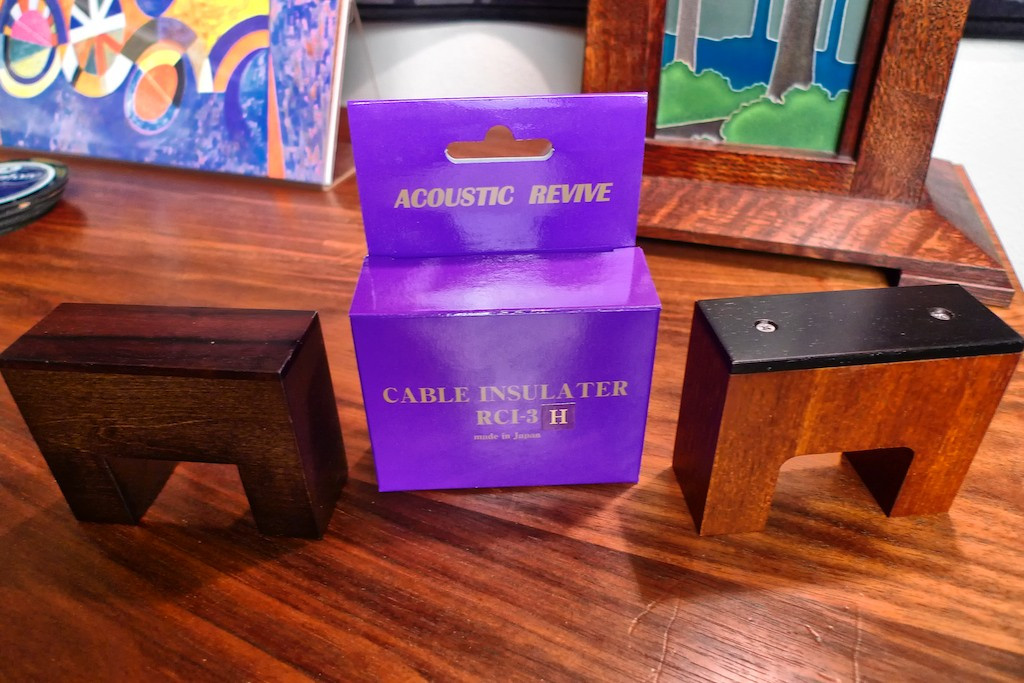Yoshi San had some late breaking information to share with me about some advanced materials that are incorporated into the PC-TripleC interconnects for noise suppression, that I wasn't able to include in the article for Positive Feedback Online, but I have included below. Enjoy!
The Acoustic Revive Chronicles: The Eleventh House!
By Jeff Day
As many of you know - and as the title reference to “The Acoustic Revive Chronicles” suggests - over the years I’ve written quite a lot about the innovative Acoustic Revive audio accessories designed by the brilliant Mr. Ken Ishiguro in Isesaki, Japan. In fact, I've spent more time writing about Mr. Ken’s Acoustic Revive accessories than I have about anything from any other single person by a long shot.
“Why?” you ask. Well firstly, because Acoustic Revive accessories have always worked great in my hi-fi rig, delivering the promised performance improvement. Secondly, they often improve system performance in ways that no other manufacturer has even thought about yet, let alone developed a product for, meaning that you can add performance to your audio system in ways that wouldn’t even be possible otherwise. Thirdly, their quality is extraordinary.
Is there a down side? Well, they’re generally fairly expensive, but you do indeed get what you pay for with Acoustic Revive accessories, so at least they’re righteously expensive. The other down side is that once you try them, you’ll find yourself wanting more, and if you've looked closely at the photos in my articles for Positive Feedback Online over the years, you've seen Acoustic Revive accessories everywhere in my Hi-Fi systems – they’re addictive!
Here’s the tally for the Acoustic Revive Chronicles so far:
- Chapter 1: The RR-77 Schumann Ultra Low-Frequency Pulse Generator – 6Moons, February 2008.
- Chapter 2: The RIQ-5010 / RIQ-5010W Quartz Insulators; QR-8 Quartz Resonators – 6Moons, March 2008.
- Chapter 3: The RCC-24 Ground Conditioner; SIP-8F RCA Input Shorting Plugs; QR-8 Quartz Resonators – 6Moons, May 2008.
- Chapter 4: The RPT-2 & RPT-4 Ultimate Power Distributors, Power Reference AC Power Cords – PFO Issue 39, September-October, 2008.
- Chapter 5: The REM-8 EMF Canceler – PFO Issue 40, November-December, 2008.
- Chapter 6: The RWL-3 Acoustic Conditioner, CB-1DB Receptacle Base Plate, the CFRP-1F Carbon Fiber Outlet Plate, and the CS-F2 Outlet Stabilizer – PFO Issue 42, March-April, 2009.
- Chapter 6 “a”: The RIO-5II Negative Ion Generator & RD-3 Disc Demagnetizer – PFO Issue 45, September-October, 2009.
- Chapter 7: The Custom Series Loudspeaker Stands, the RST-38 & TB-38 Quartz Under-Boards, and the RAF-48 Air Floating Board – PFO Issue 47, January-February, 2010.
- Chapter 8: Single Core Speaker Cables, Single Core RCA Interconnects, and the RCI-3 Cable Insulators – PFO Issue 49, May-June, 2010.
- Chapter 9: The RAS-14 AC Power Conditioner and the USB-1.0SP USB Interconnect – PFO Issue 55, May-June 2011.
- Chapter 10: The RR-777 Schumann Pulse Generator, the RL-30 Mark III Analogue Disc Demagnetizer, the CB-1DB receptacle base plate, CFRP-1F carbon fiber outlet plate, and the Acoustic Revive modified Oyaide R-1 receptacle – Issue 68, July-August 2013.
You might have noticed that the title of this article is “The Acoustic Revive Chronicles: The Eleventh House!” instead of the more predictable The Acoustic Revive Chronicles: Chapter 11. “The Eleventh House” title is my play on words to include ‘eleven,’ with a nod to Eastern philosophy where ‘The Eleventh House’ refers to the ‘House of Friends,’ with the idea being that our activities with our friends helps us achieve our hopes and dreams. So true!
In this context I’m talking about my Acoustic Revive ‘friends,’ and I have to say that over the years my ‘friends’ from Acoustic Revive have contributed quite a lot to my personal audio enjoyment, so when Mr. Yoshi Hontani (the Acoustic Revive exporter in Japan) asked me if I’d like to take a listen to a couple of new Acoustic Revive ‘friends’ - the new RR-888 ultra low-frequency pulse generator and the new PC-TripleC interconnects – I was quick to say “Yes!”
When I wrote Chapter 10, shortly thereafter I had intended to write another article in quick succession about an extra-long pair of Acoustic Revive Single Core RCA interconnects, the then-new Acoustic Revive Line-10.0RS series RCA interconnects, and the new version of the RCI-3H Cable Insulator that Yoshi San had sent to me from Mr. Ken to listen to and tell you about. Also, I promised in the Chapter 10 article to tell you about some high-performance wall electrical outlets that work well with the Acoustic Revive CB-1DB receptacle base plate and CFRP-1F carbon fiber outlet plate.
Unfortunately, the past year turned out to be a rough one for getting audio articles written, as a sudden decline in my parents health (Dad, 91, and Mom, 89) made for a year full of travel, hospital trips, getting them moved from their home in Idaho to where I live, and now taking care of them here. It was a rough period for all of us, but I’m happy to report that my parents are doing much better now. I’m still getting used to the transition from the life of a carefree bachelor to being a caregiver, but it sure is a blessing having Mom & Dad here with me so I can spend more time with them. I’m now just getting caught up on the last few review commitments from a year ago as a result, which you’ll read all about in this article. Thanks to all for being understanding, patient, and supportive of me on the writing front during a difficult time.
Review Systems
Given the theme for this review is the ‘House of Friends,’ let me reminisce a bit and re-introduce you to a couple of old friends, the Leben CS-600 vacuum tube integrated amplifier (Six Moons) and the Leben RS-30EQ phono equalizer (Issue 43), which are the beating heart of my “Music Lover’s System” that I started writing about back in 2007.
The idea behind my “Music Lover’s System’ series of articles was to present a simple, elegant, satisfying, and relatively affordable hi-fi system that served the music exquisitely well. The system I put together with the Leben CS-600 & RS-30EQ did its job of making music so magnificently well that it ended up completely changing the way I thought about hi-fi, and I ended up selling all the other hi-fi gear that I had at the time, and using my Music Lover’s System as my reference system.
In fact, using a Leben integrated amplifier & RS-30EQ phono equalizer based system, the Leben importer for the USA, Jonathan Halpern (Tone Imports), partnered with Montreal dealer Coup de Foudre, went on to make audio history at the 2008 Festival Son & Image Show and 2009 Salon Son & Image Show, where audio luminaries like John Atkinson, Robert Deutsch, Art Dudley, Steven Mejias, and John Marks heaped praise upon their simple & elegant Leben “music lovers” system.
In fact, John Atkinson said, “But the very last room I visited at FSI, one of the small ones on the 12th floor belonging to Montreal dealer Coup de Foudre, delighted me. In some ways - particularly the overall balance and the sheer accessibility of the music - this was the best I heard at the Show despite the system's affordable price.”
Yes indeed, the Leben CS-600 integrated amplifier plus RS-30EQ phono equalizer is a fine combination, a winning combination of Hi-Fi gear that punches way above its weight, winning ‘best sound of show’ over competitors with hi-fi systems that are 10 to 100 times more expensive.
My Leben based system has been providing me immense satisfaction for years, and remains my go-to system recommendation for a smaller listening room.
For this review I used both of my current systems, the Leben & Harbeth system I use in my smaller listening/television room, and my no-holds barred Tannoy & vintage McIntosh system that I use in my larger living room space. They’re both fantastic systems for the music lover!
In my small-room system I use Harbeth Super HL5 loudspeakers on Skylan 18-inch stands, Acoustic Revive Single Core speaker cables, the Leben CS-600 integrated amplifier, Acoustic Revive Single Core interconnects, the Leben RS-30EQ phono equalizer, an Auditorium 23 ‘103’ style step-up transformer, Acoustic Revive Power Reference AC power cords, a VPI Classic turntable fitted with an EMT TSD-15 phono cartridge, an Oppo BDP-83 Blu-Ray player, an Apple TV for streaming duties, and a 42-inch Philips TV.
In my living room system I use Tannoy Westminster Royal Special Edition loudspeakers with Sablon Audio Panatela internal cabling, and Duelund CAST external crossovers. Sablon Audio Panatela speaker cables connect to my restored vintage McIntosh MC225, MC30, and MC240 valve amplifiers, with Sablon Audio Panatela interconnects connecting the amps my restored vintage McIntosh MX110Z valve tuner-preamplifier and VPI Classic turntable fitted with the classic EMT TSD-15 phono cartridge. Sablon Audio Gran Corona AC power cords connect my iMac & Mhdt Labs Havana USB DAC. A long pair of Acoustic Revive Single Core PCOCC-A interconnects connect the Havana to my preamp.
In both systems I use a wide variety of the very effective Acoustic Revive accessories that I have written about in previous articles, as you can see in the photographs accompanying this article.
Acoustic Revive RR-888 Ultra Low-Frequency Pulse Generator ($695 USD)
The Acoustic Revive RR series of Schumann resonance generators, the RR-77 (now discontinued), the RR-777 (being phased out), and new RR-888, are my number one favorite audio accessories of all time.
The improvement an RR brings to the listening experience is not subtle, and I absolutely love demonstrating these little RRs to friends & visitors to my listening room, and watching the bewildered looks when they experience the RR effect for the first time. It’s not unusual for them to wonder if I’m playing some sort of trick on them. I’m not. If you can only buy one audio accessory for your Hi-Fi rig, I recommend you make it an RR, you won’t be sorry.
The Acoustic Revive RRs are based on the Schumann resonance frequency phenomena. The Schumann resonance is a natural geophysical resonant frequency mode of the Earth that occurs at approximately 7.83Hz, and was predicted mathematically in 1952 by physicist Winfried Otto Schumann, for whom the phenomena was named.
Here's how the Schumann resonance frequency phenomena works: When solar radiation strikes the Earth's outer atmosphere, molecules like NO, N2 and O2 are ionized to produce a positively charged layer called the ionosphere. The surface of the Earth has a negative charge of electricity due to transfer of electrical energy from the atmosphere. The portion of the atmosphere between the positively charged ionosphere and the negatively charged Earth surface acts as a natural capacitor where charges build up and then discharge in the form of electrical storms. These electrical storms produce electromagnetic waves in the very low frequency and extremely low frequency ranges. These naturally produced electromagnetic waves are attenuated by the ionosphere and the Earth's charged surface which functions as a waveguide. These attenuated electromagnetic waves travel around the world in the atmosphere as standing waves at the frequency of 7.83Hz and its harmonics.
Some scientists believe that over evolutionary time, biological organisms evolved to utilize the Schumann resonance phenomena as one mechanism for maintaining biological health. For an example, they point to the human brain's own electromagnetic waves that are synchronized to the Schumann frequency. In studies where people were shielded from the naturally occurring Schumann resonance frequency, their circadian rhythms were disrupted and they began to experience migraine headaches, emotional stress and other health issues. When researchers exposed them to Schumann pulse generators of 7.83Hz, their symptoms disappeared.
Dr. Guy E. Abraham, MD, a former Professor of Obstetrics, Gynecology and Endocrinology at the UCLA School of Medicine, has done some interesting research on adverse health effects on patients due to electromagnetic pollution. He found that his patients could be effectively treated using a Schumann resonance 'shield' generated by a pulsed emitter. Dr. Abraham said that "since EM pollution is due to man-made EM energy with frequencies different than the Schumann fundamental, an emitter of EM potential pulsed at the Schumann fundamental would be expected to shield the human body from the harmful effects of EM pollution." Dr. Abraham also reported how patients exposed to Schumann pulse generators experienced improved health and "a sense of well-being."
As we hi-fi enthusiasts are keenly aware, there is a lot of electromagnetic 'pollution' from signal transmissions that can degrade our system's performance. Acoustic Revive’s idea is that if Schumann pulse generators can provide a shield for EM pollution for people, then they can do the same thing for our hi-fi rigs, and thus the Acoustic Revive RR Schumann pulse generators were born. So essentially Acoustic Revive is saying that the 7.83Hz Schumann frequency pulse generated by the RRs 'shields' our HiFi electronics and listening room from radio frequency interference, thereby improving the S/N ratio so that the electronics perform better.
Acoustic Revive’s intent for their RR-77, RR-777, and RR-888 Schumann generators is to condition your Hi-Fi rig, your listening room, and you, with the Schumann frequency to improve your music listening experience (e.g. I suspect that there’s a significant Schumann conditioning effect on your noggin, which was what I think Dr. Abraham was referring to when he said his patients experienced “a sense of well-being”).
Physically, an Acoustic Revive RR Schumann pulse generator is about the size of an outboard hard drive for a computer, and it plugs into a wall outlet with a wall wart power supply, but it doesn’t plug into your Hi-Fi. Rather, it pulses the 7.83Hz Schumann frequency into your listening room. The RRs have a lightweight plastic chassis containing a single circuit board. The chassis of RR-77 & RR-777 have an attractive silver finish with contrasting gold lettering, and the RR-888 has an attractive gold finish with contrasting silver lettering. There is a power switch on the back of the RR chassis, and a blue LED illuminates to indicate when the RR is powered up. Acoustic Revive says to position the RRs 5-6 feet off the ground for the best effect.
The RR-77 was the first version of Acoustic Revive’s Schumann pulse generator, and it’s the first Acoustic Revive product I ever reviewed back in February of 2008. I love it. I’ve still got and use it all the time. Back when I reviewed the original RR-77, it was obvious that it was doing some pretty interesting things, with the sound becoming more natural, smoother, and more musically lifelike. Space also opened up in a recording's acoustic, with the music enveloping the listener, and notes decaying in a much more natural fashion. The edge, grit, or glare there was to be heard on lesser recordings also became more tolerable, and dare I say it, I felt better listening to music.
I wasn’t the only one that was impressed with the original RR-77, as both my audio pals Pete Riggle and Stephæn Harrell bought an RR-77 for their personal use after giving it a listen at my place, and those two rarely do such a thing!
The RR-77 also became an instant hit with the audio underground, and they set to work hot-rodding it with a more robust outboard power supply, and the results were impressive. A bigger power supply made for a bigger Schumann pulse and a greater beneficial effect during the listening experience.
This enthusiasm for hot-rodding was not lost on Mr. Ken Ishiguro, and he did a little hot-rodding of his own, with the result being a new model, the RR-777. The RR-777 has about four-times the Schumann pulse strength that the original RR-77 did, and replaced the now discontinued RR-77.
As you can see in the photo above, the RR-77, the RR-777, and the RR-888 are all the same size externally (although the RR-777 & RR-888 power supplies are different from the RR-77’s). For the Chapter 10 article Mr. Ken was kind enough to send two RR-777s for me to try so I could experience the effect of using multiple RR-777s in my Hi-Fi systems.
Here's a little story about using multiple RRs that I told in the Chapter 10 article that I want to repeat for you here:
“My buddy Chad and I have wiled away a good many evenings listening to great music, laughing & talking, drinking a few great craft beers, and listening to some amazing hi-fi gear. Chad retired in the last year and has now been spending time between his cabin on Lake Chelan and his place in Seattle. He stopped by over a weekend a while back to drink a few craft beers, listen to some great music, check out the awesome hi-fi gear, and laugh & talk - just like old times - it was a treat!
Chad spotted the two new RR-777s that were in for review right away, which were sitting up on my fireplace mantle next to the original RR-77. "Let's do a listening session and see if we can hear any difference when turning them on one at a time." Chad had his eyes closed and I quietly turned on the RR-77. He noticed immediately, "That's it!" The same thing happened when I turned on the second RR-777, and then the third RR-777. "Wow!" Chad exclaimed.
I'll tell you this right now: When I turned on the third RR-777 the combined effect with the first RR-77 and the second RR-777 was too much for me, as it gave me a moderate case of vertigo, and I needed to turn it off and then sit down for a moment. Chad remarked on the heady result as well.”
What I learned from that experience back during the Chapter 10 review was that RRs can be amazingly powerful devices, not only in the way they improve the sound & musicality of a hi-fi rig, but also in the way they can affect the listener.
I have been using two RRs (an RR-77 plus an RR-777) together in my larger listening room (it is 27’6’’ long, by 20’4’’ wide, and with variable ceiling height from 9 to 20 feet), and I’ve been very pleased with the results. I place mine on my fireplace mantel which is about 5-feet off the ground. I’ve found that two RRs is just right in that room, and if I add a third RR the effect becomes too strong, as I’ve mentioned earlier. However, with a room larger than mine, you might find that you benefit from a third or more RR. You’ll just have to experiment to find out. In my smaller spare bedroom that I use for a listening/video room (11’ by 12’, with a 9’ ceiling), I’ve found one RR-777 to be just right.
In magnitude, how big is the difference that these RR devices make? Big. As my buddy Chad put it during that Chapter 10 RR listening session, "Most people would hear more of a difference in their system by adding an RR than they would from buying a new amplifier." Chad was exactly right; the magnitude of the change was indeed impressive.
Enter the RR-888: The new RR-888’s most obvious difference from the RR-777 is the gold finish of the chassis. They both use the same power supply for the same amount of Schumann pulse strength. According to Acoustic Revive, the RR-888 has an improved “accuracy of the waveform” and a “further low-noise circuit” that offers a performance improvement over the RR-777.
To put the new RR-888 through its paces, I listened to a whole range of music, including excellent FM music from National Public Radio, streamed world class jazz from Jazz24, and a lot of great vinyl, like the superb Riverside solo Monk album, Thelonious Alone in San Francisco, issued on 45-RPM limited edition records by Analogue Productions (mine was number 777, how cool is that!).
As with the original RR-77, and the RR-777, the RR-888 definitely accentuates the positive and minimizes the negative (to paraphrase Johnny Mercer). Musicality was accentuated, with the musical elements of tone, melody, rhythm, emotional impact, and musical flow all being enhanced. Non-musical artifacts of the recording process like soundspace, soundstage, imaging, resolution, and so forth, all improved as well, with the added bonus of having a dollop of naturalness applied to them so that they add to the pleasure of the musical experience instead of distract from it, like recording artifacts sometimes can.
The RR-888 solo: I couldn’t reliably tell any difference between the performance of the new RR-888 and the RR-777 it replaces, as they both seemed to perform at approximately the same level of musical enhancement. There were times when I thought that with the RR-888 musical notes decayed for a little longer, that the soundstage was slightly more spacious, and that perhaps there was a subtly more dynamic presentation of the music. At other times I thought they sounded the same. If there are differences between the levels of performance of these two models of RRs, they are subtle, but regardless, they are both extremely impressive devices.
RR combinations: The effect of combining an RR-777 plus RR-888 in my larger listening room was not subtle, and that pairing was noticeably stronger in their sonic & musical effect due to the increased Schumann pulse strength than the RR-77 plus RR-777 combination that I normally use. Certainly multiple RRs being powered up made a more noticeable difference than I heard between the individual models. The combination of an RR-777 plus RR-888 provided more musical & sonic enhancement than the combination of the RR-77 plus RR-777. But there were times when I thought their combined effect on this listener was a little bit too much of a good thing, making me feel like I had a mild case of vertigo. So the verdict is still out which is the better pairing for my big listening room, the RR-77 plus RR-777 (or RR-888), or the RR-777 plus RR-888 combination.
One thing that occurred to me after trying these different combinations of RRs was that it would be nice if there were a model of Acoustic Revive RR that had an adjustable Schumann pulse strength. That way you could dial its pulse strength for your particular room size, and for those who are more sensitive to its physical effects (like me apparently), you could fine-tune it so it doesn’t overtly affect how you feel.
I've been steadily listening to Acoustic Revive RRs since 2007, and I still find them to be the most easily recommendable audio accessories out there, and I definitely wouldn’t want to be without one (or two, or three, as the case may be). I’ve said it before; these little RR Schumann generators are amazing devices, and are a no-brainer purchase. At $695 USD, the RR-888 seems expensive for what it seems to be, a little plastic box with a circuit board inside, but it is a musical bargain at that price, and before you make any other change you think you need in your hi-fi system, try an RR-888 first, because I suspect it will transform your listening experience, and you might not need anything else after that. The RR-888, like the RR-77 and RR-777 before it, is absolutely, unequivocally, and enthusiastically recommended.
Breaking news: While Ron & Sumi and Cindy & I were all at the Camerata Musica chamber music concert the other night, my buddy Ron told me he bought an RR-888 of his own after listening to mine for awhile. Let that be a warning for you! If you spend a little time listening to an RR-888 you will not be able to resist one of your own!
Acoustic Revive Single Core PC-TripleC, PCOCC-A, and Line-1.0RS RCA Interconnects
The Acoustic Revive Single Core PC-TripleC Interconnects
New Information: Yoshi San told me there was an important aspect of the PC-TripleC interconnect cables that I did not mention in the article for Positive Feedback Online, and he was eager for me to share that information with you. In addition to the new conductors in the PC-TripleC interconnects, there are also new advanced materials employed for noise suppression incorporated into the PC-TripleC interconnects, called FINEMET beads developed by Hitachi Metals, Ltd., that cancels noise to give a "a super high S/N ratio and a dramatic improvement in sound quality without sacrificing any sound and musical elements of the master sound source."
The Single Core PC-TripleC RCA interconnects are the flagship interconnect from Acoustic Revive ($2475 USD for 1-meter, $815 USD for each additional half-meter), and builds upon the design strengths of the Single Core RCA interconnects that it replaces in the Acoustic Revive product line.
Acoustic Revive is dedicated to using a single conductor (thus the naming convention as ‘Single Core’) because they believe a single conductor gives the best performance. Acoustic Revive says that single conductors are superior because electric current radiative effects emanating from multiple conductors introduces subtle distortion of the signal that degrades performance, which does not happen when you use a single conductor.
The biggest change in the new Single Core PC-TripleC RCA series of interconnects is the use of the new PC-TripleC conductor used in their construction. Acoustic Revive is very excited about the performance of new PC-TripleC conductor.
In the brochure for the PC-TripleC interconnects, there is artwork in the upper right-hand part of the brochure of a Japanese blacksmith preparing a Samurai sword through a forging, hammering, and folding process. Can you guess how the new PC-TripleC conductors are made? If you guessed that they are made just like a Samurai sword that is forged, hammered, and folded, you’re exactly right.
To quote from the Acoustic Revive brochure, “Copper is compressed to 70% by forging tens of thousands of times by gradual application of pressure with a fixed angle and direction (the constant angle continuation transfer forging method). By using this forging process, the transverse crystal grain boundary changes and becomes more longitudinal, crystals now have consecutive connections, which make current flow extremely smooth. In addition, by forging, the conductor density is dramatically improved by destroying the internal air grains. This, in turn, improves the conductivity and the acoustic signature of the copper. PC-TripleC wire after “Continuous Crystal Construction” process is further processed by Transfer Forging method for thinner wire. Then Annealing process is carried out under a temperature and time control depending on the thickness of the wire. In result, crystals fuse each other and change into more consecutive crystals.”
The PC-TripleC conductors are covered with a natural silk dielectric, which Acoustic Revive says gives a more natural and spacious feel to the music. The silk covered PC-TripleC conductors are then covered with Teflon coated flexible copper tubing that provides 100% shielding from RFI. Acoustic Revive then covers the entire cable assembly with mesh polyurethane tubing containing embedded carbon particles that provides additional shielding and vibration isolation.
The Acoustic Revive PC-TripleC interconnects are terminated with solder-less connectors that are works of art all by themselves, looking more like they were made by a maker of fine jewelry than an audio company, and whose materials are of extreme quality. Acoustic Revive doesn't like soldered connections as well as solder-less because "solder reduces conductivity and sound quality."
Acoustic Revive's flagship PC-TripleC series of cables are constructed entirely by hand, and given the ultra-quality of the materials, and the fanatical attention paid to quality of construction, it should come as no surprise that they are expensive. If you're trying to save money in these difficult economic times, I'd say you might want to look elsewhere. However, if you're not troubled by their cost, and are looking for exceptional sonic and musical performance in an ultra-quality product, then please keep reading.
Yoshi San (the Acoustic Revive exporter) told me that in the highly respected Japanese hi-fi magazine called “Cable Encyclopedia,” that all fourteen of the audio journalists who write for the magazine selected the Acoustic Revive PC-TripleC when they were asked to identify what their favorite cables were. As you might imagine, there’s a huge wave of popularity that the PC-TripleC interconnects are riding in the Japanese audio scene right now, so I was especially curious to hear what the new PC-TripleC interconnects would do in my hi-fi rigs.
In my Leben & Harbeth system I installed a complete set of Acoustic Revive Single Core PC-TripleC RCA interconnects in place of the Acoustic Revive Single Core PCOCC-A RCA interconnects that I normally use. So there’s a PC-TripleC interconnect from the VPI Classic turntable to the Auditorium 23 step-up transformer, then a PC-TripleC interconnect from the Auditorium 23 step-up transformer to the Leben RS-30EQ phono stage, and a PC-TripleC interconnect from the RS-30EQ to the Leben CS-600 integrated amplifier.
The Acoustic Revive Single Core PCOCC-A RCA Interconnects
As I mentioned earlier, when I wrote Chapter 10, shortly thereafter I had intended to write another article in quick succession to tell you about a very special extra-long pair of Acoustic Revive Single Core PCOCC-A RCA interconnects that changed my life in a very positive way, but a family crisis intervened and delayed the write-up until this article.
During that crisis period the top-of-the-line Acoustic Revive Single Core PCOCC-A interconnects became the Acoustic Revive Single Core PC-TripleC interconnects. The primary difference between the new PC-TripleC interconnects and the previous generation of interconnects are the conductors used in their design. The previous PCOCC-A (Pure Copper by Ohno Continuous Casting) conductor used was an ultra-high purity (greater than 8-Nines, or 99.999999%) single-crystal copper wire that has been annealed - the 'A' in PCOCC-A - to increase its pliability and conductivity. 6-Nines or less is what you see in almost all other cables, and Acoustic Revive tells me the measurable and audible difference between the performance of 6-Nines conductors and their 8-Nines conductors is profound, and well worth the extra effort and expense involved in producing them. Acoustic Revive also makes a point of saying that the oval shape of their PCOCC-A conductors means they do not have a resonance point, which contributes to a smoother, more transparent, three-dimensional, and articulate sound compared to other kinds of conductors. Other than the conductors used, the design and construction of the new PC-TripleC interconnects and the previous PCOCC-A interconnects are identical, with the only visible difference being the new ‘PC-TripleC’ label on the casing.
The long interconnects (3-4 meters) I have previously tried in my Tannoy & vintage McIntosh system to go from the Mhdt Labs Havana USB DAC to my McIntosh MX110Z tuner-preamplifier were plagued with issues related to not being shielded or grounded (you could hear radio broadcasts through the system because they were acting like an antenna, etc.). This issue eventually led me to abandon the use of a digital front end in my Tannoy & vintage Mac system, which was a bit of a bummer.
When I told Yoshi San about the issues I was having getting long interconnects to work for me, he told me he thought the shielding approach used in the Acoustic Revive Single Core PCOCC-A (and now PC-TripleC) interconnects would make them immune to RFI, and so they would be the ideal candidate for a long interconnect in a problematic environment. Mr. Ken made up a pair of long interconnects for me to try and they worked like magic to eliminate RFI nastiness!
To my absolute delight I was able to reinstall a digital front end to my Tannoy WRSE & vintage McIntosh system and enjoy listening to digital media again, and in particular I absolutely love streaming jazz from the world class jazz station Jazz24 in Seattle & Tacoma, Washington. If you are a jazz music lover and haven’t checked out Jazz24 yet, I highly recommend it, as there’s a reason it “has won numerous national accolades including the Edward R. Murrow for news, and the Marconi for Jazz Station of the Year.”
If an album isn’t on my turntable, chances are pretty good I’m streaming Jazz24 through the Acoustic Revive Single Core PCOCC-A RCA interconnects while I’m reading, writing, cooking, or snuggling with my sweetie. Thank you Yoshi San and Mr. Ken for making my musical world complete!
I highly recommend these long Acoustic Revive Single Core PCOCC-A RCA interconnects for their 100% shielding from RFI, their terrific musical & sonic qualities, and their astonishingly high quality of construction. If you live in an environment where RFI is problematic and you need a long pair of interconnects, then the Acoustic Revive Solid Core PCOCC-A RCA interconnects are the answer to your problems. The new Acoustic Revive Single Core PC-TripleC RCA interconnects are the current version of the top-of-the-line Single Core RCA interconnects, and they use exactly the same shielding approach, so I would expect the new PC-TripleC RCA interconnects to perform every bit as good or better than the PCOCC-A RCA interconnects I use now. It boggles the mind!
The Acoustic Revive Single Core Line-1.0RS RCA Interconnects
The Acoustic Revive Line-1.0RS series of RCA interconnects were introduced as Acoustic Revive’s ultimate “price vs. performance ratio” interconnects. The flagship Acoustic Revive Single Core PC-TripleC RCA interconnects weigh in at a hefty $2475 USD for a 1-meter pair (and $815 USD for each additional half-meter), while the Single Core Line-1.0RS series of RCA interconnects comes in at a much more wallet friendly price of $485 USD for a 1-meter pair (and $215 for each additional half meter).
Acoustic Revive says the Single Core Line-1.0RS RCA series of interconnects draws from everything they’ve learned building their flagship cables. The Line-1.0RS interconnects use a PCOCC-A single-wire conductor that is covered with a “fluorine system resin” which is then placed in a natural silk casing. That cable assembly is then wrapped with a copper-foil shield, which Acoustic Revive says achieves 100% RFI shielding. The entire cable is then place in a “Carbon SF” tube to protect it, and which Acoustic Revive says also “prevents exterior noise and radiation noise” from degrading cable performance.
The Line-1.0RS interconnect cables are terminated with “an anti-vibration RCA plug made from a solid block of 2017S air craft grade aluminum alloy” that Acoustic Revive says is “hot on the heels” of their flagship RCA connectors, with the slight concession that it uses soldered connections to keep costs down, rather than the spendy solderless connections used in the Single Core PC-TripleC RCAs.
Listening Impressions: PC-TripleC, PCOCC-A, and Line-1.0RS RCA Interconnects
To gather my listening impressions I listened to a bunch of 45RPM reissue albums, like Classic Records’ 45RPM reissue of Bill Henderson’s Live At The Times, ORG’s 45RPM reissue of Bill Evans Trio Trio ’65, Analogue Productions’ 45RPM reissue of Thelonious Monk’s Alone in San Francisco, Music Matters 45RPM reissue of The Jazz Messengers At the Café Bohemia Volume 1, and the like, because those ultra-high fidelity 45RPM reissue records are my favorite way to give fine hi-fi gear a workout to test their level of performance.
After listening to the Acoustic Revive Single Core RCA interconnects – the PC-TripleC, PCOCC-A, and Line-1.0RS – over a broad spectrum of 45RPM records, I came to the conclusion that they all share a familial or ‘house’ sound, which can be broadly characterized as a relaxed clarity with a huge sense of ambient space, a musicality that included a high degree of timbral realism, excellent tone color resolution, a convincing portrayal of tempo, dynamics, melody, beat, and rhythm, which when taken together created a strong emotional connection to the music. They’re all really good interconnects.
PC-TripleC RCA Interconnects ($2475 USD)
When listening to Classic Records’ 45RPM reissue of Bill Henderson’s Live At The Times with all PC-TripleC interconnects, I was immediately struck by how smooth and transparent they were. Because of their transparency and resolution, the PC-Triple interconnects gave more of a ‘you are there’ at a performance style of presentation, than a ‘they are here’ style of presentation, like you get with the PCOCC-A interconnects. The PC-TripleC interconnects have a lighter overall balance than the PCOCC-A interconnects, but they still have a natural - but neutral - portrayal of timbre and tone color. The bass response of the PC-TripleC seemed subjectively deeper and more resolved than that of the PCOCC-A interconnects, and they are very well balanced from bottom to top. The PC-TripleC interconnects did make surface noise of records a little more obvious than with the PCOCC-A interconnects.
When listening to Monk’s Alone in San Francisco the PC-TripleC was more dynamic, percussive, and had much more ‘playing’ information coming from the pedals than my reference PCOCC-A interconnects. This Analogue Productions 45RPM reissue is a great record, by the way, and my favorite Monk recording. Don’t miss this one!
When I was listening to The Jazz Messengers’ At the Café Bohemia I decided I really wanted to crank up the volume, and a revelation dawned on me when I did so: the PC-TripleC RCA interconnects really came into their own when the volume goes up, giving me a really clear window into all the details of the music-making, yet without playback getting overly analytical or harsh. The PCOCC-As are good in this regard as well, but the PC-TripleC took it to the next level.
When listening to ORG’s 45RPM reissue of Bill Evans’ Trio ’65 I heard more of the fine structure in the fabric of the music-making with the PC-TripleC interconnects than I did with the PCOCC-A or Line-1.0RS interconnects. While the PC-TripleC interconnects are more resolving, and I could hear more of the tactile workings of the musicians as they played, they always sounded smooth and natural. With the PC-TripleC interconnects the saturation of tone color was stepped down a notch, they had a brighter & more detailed soundstage, and there was less contrast between the instruments & soundstage space, when compared to the PCOCC-A. The PC-TripleC sounded more transparent & resolving than the PCOCC-A, and with tempo, beat, rhythm, and melody all being artfully expressed. The PC-TripleC has extraordinary imaging, natural timbre, and a lot of layering back into a wide & deep soundstage. I really got a good sense of the tactile aspects of musicians’ playing, like with Chuck Israels’ bass playing, which gave a real sense of his finger-work on the strings.
PCOCC-A RCA Interconnects (replaced by the PC-TripleC)
While listening to Monk’s Alone in San Francisco I came to the conclusion that the Single Core PCOCC-A is not quite as ‘snappy’ from a tempo, dynamics, and melody standpoint as the new PC-TripleC or Single Core Line-1.0RS RCA interconnects, but it always sounded very natural and engaging, with good timbral realism, and with deeply beautiful tone color resolution. The PCOCC-A presents the music in more relaxed fashion, where the PC-TripleC & Line-1.0RS interconnects came across as more energetic dynamically.
On Trio ’65 record the PCOCC-A interconnects put the images closer to me and sounded louder for the same volume setting than the PC-TripleC did. The tone color was more deeply hued with the PCOCC-A interconnects than with either the PC-TripleC or Line-1.0RS, with an almost Kodachrome like effect, where tone color was rendered in a rich, deeply colorful way. The PCOCC-A was darker and with less sense of the ambient space of the soundstage than the PC-TripleC, which lit up the instruments and the soundstage more. From a tempo, melody, rhythm standpoint, the PC-TripleC sounds more dynamically agile, and quicker on ‘its feet.’ The PCOCC-A is darker and more relaxed sounding than the PC-TripleC.
Line-1.0RS RCA Interconnects ($485 USD)
Here’s some really good news: the new Single Core Line-1.0RS RCA interconnects that are Acoustic Revive’s entry level offering, come very close in performance to the former top-of-the-line PCOCC-A interconnects that I know & love, and they do it at about one-fifth the price. Acoustic Revive wasn’t kidding when they heralded the Line-1.0RS RCA interconnects as a price-performance breakthrough, they sounded remarkably similar to the Single Core PCOCC-A interconnects that were five times their price!
When I put Monk’s Alone in San Francisco on the turntable, the Single Core Line-1.0RS RCA interconnects sounded very tuneful in tempo, melody, beat, and came across as dynamically energetic, in the driving sort of way that Garrard 301 turntables are known for. The Line-1.0RS RCA interconnects also displayed lots of very natural sounding resolution & inner detail, and projected images with a lot of physical presence, like Monk’s piano, which became a percussive, vibrating, stomping treat between my speakers. I jotted down in my listening notes a number of times how well the Line-1.0RS RCA interconnects communicated the emotional content of the music – they really drew me into the music!
When I was listening to Bill Evans Trio’s Trio ‘65 I thought the Single Core Line-1.0RS RCA interconnects sounded remarkably similar to the Single Core PCOCC-A interconnects, being very musically involving, and excellent in getting across the right feel for various tempos, beats, melodies, and rhythms.
When listening to Bill Henderson’s Live At The Times I was again struck by the fact that the new Single Core Line-1.0RS RCA interconnects sounded remarkably similar to the Single Core PCOCC-A interconnects. They’re not quite as smooth sounding as the PCOCC-A interconnects, and surface noise of records – for example – comes through as more pronounced. The have a huge sense of space, just the right amount of resolution, an excellent portrayal of timbre and tone color, a natural flow of tempo and melody, and a relaxed clarity. I really enjoyed what I was hearing through the Single Core Line-1.0RS RCA interconnects, as they really make the music beautiful and fun to listen to.
Summing Up the PC-TripleC, PCOCC-A, and Line-1.0RS RCA Interconnects
While all three of these interconnects shared a familial house sound of relaxed clarity, a huge sense of ambient space, a high degree of timbral realism, excellent tone color resolution, an artful portrayal of tempo, dynamics, melody, beat, and rhythm, they each fell at a different place on the spectrum of those traits. So with those familial factors firmly in mind, now let me try to give you a better feel for the differences between these interconnects, which I’ll describe in terms of brightness, contrast, saturation, and resolution.
I’m not using ‘brightness’ here as it’s frequently used, to describe the trait of having too much high frequency energy, but rather as the overall ‘lighting’ level of the soundstage and images. For example, let’s say you’ve got four musicians playing on a stage with the house lights turned down low, but with a spotlight on each of them. While leaving the spotlights on each musician, imagine that we turn up the house lights by 25% so you can see the outlines of the surrounding equipment on the stage, but not all their details. Then imagine that we turn up the house lights up to 75% so the whole stage pops to life with all the details clearly evident, so that you can see all the details of the equipment, all the power cords running across the floor, and so forth. The brightness I’m talking about here is like turning up the house lights, which illuminates the spaces between the images of the musicians, but it doesn’t make things sound brighter from a high frequency energy perspective.
With ‘brightness’ in the ‘house lights’ context, the PC-TripleC interconnects are the brightest of these three pairs of interconnects, illuminating the soundstage rather dramatically. The PCOCC-A interconnects are the darkest of the three, and more like the example I used above of musicians on a stage with spotlights, but with the houselights turned all the way down and the stage dark all around them. The Line-1.0RS interconnects are more brightly lit than the PCOCC-A interconnects, but not by a lot, and they are quite a lot darker in their presentation the PC-TripleC interconnects
Now let’s talk about the ‘contrast’ of these three pairs of interconnects in relation to each other. I’m using ‘contrast’ in the same sort of visual sense that I was using ‘brightness’ above. So ‘contrast’ is referring to the magnitude of difference between the lightest and darkest aspect of the recording’s soundstage as presented by these interconnects. The PCOCC-A interconnects have the most contrast because they have a very black space between images, with aural ‘spotlights’ on the musicians’ images. The PC-TripleC interconnects have the least amount of contrast because the images and the space between the images are about equally lit up. The Line-1.0RS interconnects have less contrast than the PCOCC-A interconnects because the stage is a little brighter between images, but not by much, but they have more contrast than the PC-TripleC interconnects.
Now let me describe the ‘saturation’ in the way these three interconnects present a record. With ‘saturation’ I’m referring to the tone color or timbral textures of voices and instruments. If I were talking about a photograph, more saturation would correspond to deeper and more vibrant colors, and less saturation would correspond to lighter and less vibrant colors. In the sense of tone color & timbre, more saturated means more starkly evident aural textures for a given instrument, which for a guitar could be a woodier, richer, more resonant, balanced body-to-strings sound, style of presentation. Less saturated for that same guitar would imply lighter and more laid back timbral textures, with a less woody, less rich, less resonant, less balanced body-to-strings sound style of presentation, where the sound of the strings might be emphasized with respect to that of the body, for example. The PCOCC-A interconnects have the most saturation, with more deeply hued tone colors, richer timbral textures, and a more vibrant Kodachrome-like presentation of tone color than the PC-TripleC or Line-1.0RS interconnects do. The Line-1.0RS interconnects are pretty close to the deep hued saturation of the PCOCC-A interconnects, being only slightly less saturated, smooth & rich sounding. The PC-TripleC interconnects don’t have that Kodachrome-like saturation of the PCOCC-A, sounding more neutral & life-like from an accuracy standpoint, but perhaps not more beautiful from an artistic standpoint.
Finally let me discuss the ‘resolution’ of these three pairs of interconnects in relation to each other. All three pairs of these interconnects are highly resolving, and each of them portray that detail is a smooth and natural way. The Line-1.0 interconnects have about the same level of resolution as the PCOCC-A interconnects, but the latter presents that detail in a richer and smoother fashion. The PC-TripleC interconnects are by far the most resolving of these three pairs of interconnects, and that is in part linked to their brighter presentation, which turns on the light for all of the details of a recording. You can hear lots of details, but they never sounded etched or objectionable, and in fact it was quite the opposite, they sounded smooth & enticing, getting down to the fabric of the music in a very pleasurable way.
Follow-Up: Acoustic Revive CB-1DB Receptacle Base Plate ($325 USD) & CFRP-1F Carbon Fiber Outlet Plate ($300 USD) with Oyaide R-0 ($147 USD) and cruzeFIRST Audio Maestro ($85 USD) Outlets
If you read my Chapter 10 Acoustic Revive Chronicles article back in PFO Issue 68, you know that I was very impressed with the combination of the Acoustic Revive CB-1DB Receptacle Base Plate, CFRP-1F Carbon Fiber Outlet Plate, and the custom Acoustic Revive modified Oyaide (pronounced "Oh-yah-ee-day") R-1 AC outlet (not commercially available) on my hi-fi system’s performance.
It turned out that upgrading the two wall outlets that I plug my components into with premium outlets, and installing rigid base plates & carbon fiber outlet plates, made for one of the biggest hi-fi system bang-for-the-buck sonic & musicality improvements I’d ever run across. That experience taught me that the performance improvement of adding high-performance AC outlets was so significant that it’s probably the first thing a hi-fi enthusiast should do when setting up a new listening room (or when improving an old one!).
Let me refresh your memory on how the CB-1DB Receptacle Base Plate and the CFRP-1F Carbon Fiber Outlet Plate work to improve system performance:
Equipment footers & isolation platforms improve the sonics of your gear by reducing or eliminating the mechanical vibration coming up through your equipment stand from the floor. The idea is that when your Hi-Fi equipment is rattled around by vibration it introduces electrical noise into the signal path that degrades the signal-to-noise ratio of the electronics, resulting in poorer sound from your hi-fi rig. By reducing the vibration you increase the signal-to-noise ratio, allowing your equipment to function as it was intended to, the result being better quality sound. When you put in isolation devices that truly decouple your hi-fi gear from vibration, the improvement is impressive from both a musical and audiophile sonic perspective.
While its not intuitively obvious, after you’ve decoupled your hi-fi equipment from floor borne vibration via footers, isolation platforms, and the like, there is still a major source of vibration that goes directly into your electronics that you haven't yet addressed, and might not have even realized was present: the vibration path from the AC mains connection that goes directly into each component. AC outlets are a source of vibration transmission that goes directly into your equipment, from normal floor borne mechanical vibration, and from the vibration produced by the 60Hz cycling of AC in the power grid. Which means that the power cord from your equipment that plugs into the wall outlet serves as a vibrational link from the AC outlet to your electronics, degrading their signal-to-noise ratio, and thereby reducing their audio performance.
The CB-1DB Receptacle Base Plate and the CFRP-1F Carbon Fiber Outlet Plate reduce the amount of vibration coming through the AC outlet and into your equipment. If you think of these devices like equipment footers or isolation platforms for your wall outlet that dissipate vibrational energy before it gets into your equipment to degrade their sonic performance, then you've got it. I cover how all this works in more depth back in the Chapter 6 and Chapter 10 articles if you’d like to learn more about it.
The custom Acoustic Revive modified Oyaide R-1 outlets that were sent to me to show off the performance potential of the receptacle base plate and carbon fiber outlet plate are amazing, but unfortunately they are not available to purchase. So I felt I had to find some high-performance outlets that I could recommend, and you weren’t just left hanging.
Safety Caution: While the CB-1DB receptacle base plate, the CFRP-1F carbon fiber outlet plate, and modified Oyaide outlets were easy to install, before you attempt to do the same sort of thing, be sure you shut off the circuit breaker at the main service panel, and then test the circuit with a multi-meter to be sure it's off, before you proceed with installation. You don't want any power going to the outlets while you’re doing the installation or you could have one of those zap & thud moments that could end your audio pursuits forever. You've been warned! If any of this makes you at all nervous, then I recommend you hire an electrician to do the installation for you.
As I reported earlier, the CB-1DB receptacle base plate and CFRP-1F carbon fiber outlet plate installed into my outlets made an impressive difference even with normal household outlets: Transparency opened up; the sense of space increased, there was more recorded detail in evidence, the bass lines became deeper and more articulate, musical notes trailed off with more realistic decay, the timbral signature of the body of the instruments became more evident, and the music came across as more naturally 'live' with more 'snap' to the notes, and with greater musical flow.
Installing the custom Acoustic Revive modified Oyaide R-1 outlets in place of my stock outlets opened up the sound even more, and they were a real ear-opener both musically and sonically. I have come to think of this trinity of outlet upgrades as the equivalent of an in-wall version of an RPT-2 Ultimate Power Distributor. It's really, really, a good upgrade for a high-performance hi-fi system, and it made it clear to me that good sound & music quality starts with what you are plugging your components into at the wall AC outlet.
One thing that I should mention is that I found out that all of the high-performance outlets used in this article benefited from preconditioning with my Audiodharma Anniversary Cable Cooker, just like interconnects, speaker cables, and power cords do. Preconditioning outlets made them perform noticeably better: they got smoother, silkier, more resolving, and altogether more musical.
Out there in the audio underground a couple of the most highly regarded high-performance AC outlets are the Oyaide R-0 outlet ($147 USD), which is an unplated version of the R-1, and the Maestro outlet ($85 USD), which was developed by Fernando Cruz at cruzeFIRST Audio. I’ve found the audio underground to be a pretty reliable source of information, so I thought I’d check out the R-0 & Maestro and tell you about my experiences with them, and how they compare to the Acoustic Revive customized Oyaide R-1.
The Acoustic Revive customized Oyaide R-1, the Oyaide R-0, and the cruzeFIRST Audio Maestro outlets are all high-performance audio outlets, and each one of them easily outperforms the generic wall outlets installed in homes. They also sound very different from each other, with each one falling at a different place on the sonic & musical spectrums of performance, which will make one of them more suitable for a given listener & hi-fi system depending on personal taste and system voicing. These outlets provide such a dramatic performance increase for a hi-fi system, that after listening to them I tossed my generic outlets into the trashcan. One listening session with a high-performance outlet providing the juice and there’s no going back! Here are my conclusions about these three outlets:
Acoustic Revive Customized Oyaide R-1 Outlet: The customized Acoustic Revive outlet uses a special version of the Oyaide R-1 receptacle. The ARC R-1 outlet uses a beryllium-copper electrode, because Acoustic Revive says that the beryllium-copper electrode has better conductance characteristics. Acoustic Revive polishes the electrode to a mirror finish to further improve conductance. Then they modify the electrode parts of the R-1 by applying a thick silver plating, followed by a thick rhodium plating, both of which they say improves the conductance and phase characteristics over a stock R-1. After the plating modifications they cryogenically treat the electrode parts at -196 degrees C for an additional improvement to conductance. After all the internal electrode parts are cryogenically treated they are reinstalled into Oyaide resin receptacle bodies.
The ARC R-1 outlet kicks fanny on the Oyaide R-0 and the cruzeFIRST Audio Maestro outlets by quite a lot. The ARC R-1’s quality of construction and the level of customization were astonishing to behold. If the Museum of Modern Art had an outlet on display, the ARC R-1 would be it.
From a more practical standpoint, the ARC R-1 clamps down on the AC wires like a vise, making installation into the wall much easier, and once installed it also grips the prongs of AC power cords very firmly, which helps keep massive & stiff power cords solidly in place, like the Acoustic Revive Single Core and Sablon Audio Gran Corona power cords that I typically use in my hi-fi rigs.
The improvements to sonics & musicality that the ARC R-1 brought to my Tannoy & vintage Mac hi-fi system were astonishing. If the ARC R-1 were a film for a camera it would be Kodachrome, with its brilliant but never garish color palette, and if you shot it right it gave an explosion of light & color that made for magically life-like & artful photographs – that’s the ARC R-1.
In a Kodachrome-like manner, the ARC R-1 provided music full of light & color, with magically life-like & artful portrayals of tempos, beat, rhythm, melodies, and dynamics, along with deeply hued tonal colors, and shockingly realistic timbres. The ARC R-1 also provided rock-solid imaging, along with a wide, deep, and naturally tall soundstage, a vast sense of space, and pretty much every sonic superlative you could throw at it. It also provided the best emotional connection to the music of all the outlets tested. The ARC R-1 outlet was easily the highest performing outlet in this group.
It’s amazing what the ARC R-1 outlet did to improve the performance of my hi-fi system. But the ARC R-1 is not for sale so you can’t buy it! I know, first I tell you it’s the best, and then I tell you that you can’t buy it – life is cruel that way. If you could buy the ARC R-1 I’m guessing it would be very expensive. A stock R-1 outlet costs $179 USD, and given the nature of the modifications and handiwork that goes into crafting an ARC R-1, I’m guessing it would sell for around $500 USD if you could buy one, but you can’t.
The Oyaide R-0 Outlet: The Oyaide R-0 and R-1 outlets were developed specifically for audio applications, and are non-magnetic to minimize any possible degradation from magnetic fields. The Oyaide R-0 outlet is essentially an unplated version of the Oyaide R-1 outlet. The Oyaide R-0 has an unplated, highly polished, beryllium-copper electrode, and a heavy-duty mounting bracket that is 24k gold-plated brass. The Oyaide R-0 body is an insulator made of glass-filled nylon, which Oyaide says gives it high rigidity, resonance absorption, and safe insulation properties. The quality of construction of the Oyaide R-0 is of extraordinarily high quality.
Like the ARC R-1, the Oyaide R-0 clamps down on the AC wires like a vise, making installation into the wall a snap, and it also grips the prongs of AC power cords very firmly, holding my Acoustic Revive Single Core and Sablon Audio Gran Corona power cords solidly in place.
I used to love shooting Kodachrome in my Leica MP film camera, but now it’s extinct. So what do you do when you can’t buy Kodachrome? Well, it’s hard to go wrong with Fuji Reala, with its smooth extra-fine grain, superb color accuracy with excellent saturation, and it always delivers natural color reproduction and sharp results.
If the ARC R-1 outlet is Kodachrome, then the R-0 outlet is Fuji Reala. The Oyaide R-0 doesn’t quite have that Kodachrome-like magic of the ARC R-1, but it does have that Fuji Reala-like smoothness, lack of grain, natural timbral & tone color reproduction, combined with a realistic level of transparency. The R-0 is does very nicely both musically & sonically, and I can see someone who wants a little bit more laid back, very natural sounding presentation preferring the R-0 to the ARC R-1. Like the ARC R-1, the R-0 is a ridiculously good outlet both musically & sonically, and if I were going to purchase something for my own use the R-0 would be it. As I said above, the R-0’s quality of construction is astonishingly good.
While I didn’t think the R-0 quite matched the ARC R-1’s presentation of tempos, beat, rhythm, melodies, dynamics, deeply hued tonal colors, and timbral realism, it was still fantastic. The same goes for imaging and soundstaging, sense of space, and resolution, where the R-0 is not as vivid sounding as the ARC R-1, but it’s still so ridiculously good that’ll you’ll be patting yourself on the back for buying an R-0. The R-0 actually comes pretty close to the ARC R-1 in emotional connection to the music, and if you’ve never used a high-performance outlet before, I think you’ll be floored by the difference it’ll make in a system. If I were laying down my own money the R-0 would be the high-performance outlet I’d buy.
The cruzeFIRST Audio Maestro Outlet: Like the R-0, the cruzeFIRST Audio Maestro outlet is an audio underground favorite. cruzeFIRST Audio’s Maestro outlets are 20-amp rated, use an electrode of “high-purity copper/brass alloy mix with no plating,” that “mechanical resonance and tuning is also important,” that the outlet is cryogenically treated then “treated with our special coating for RFI/EMI interference rejection and enhanced for mechanical dampening,” and that the Maestro outlet “is taken through our proprietary break-in process for 2 weeks.” So like the ARC R-1, there’s a lot of thought and modifications that go into a cruzeFIRST Maestro outlet.
The Maestro has a thin stamped metal backstrap in contrast to the thick brass backstraps of the Oyaides, and the Maestro has a lightweight plastic body that is less substantial and more resonant when compared to the Oyaide R-0’s more substantial and non-resonant glass-filled nylon body. The higher quality of construction of the Oyaides compared to the Maestro is immediately obvious, as it should be at the Oyaides’ higher price.
The Maestro’s clamping mechanism doesn’t hold the AC wires in place as tightly as the R-0’s. In the R-0 there is an internal clamp that holds the wires firmly in place when you tighten down the screws, and you can’t get the AC wires to loosen even when twisting the body around while mounting it into a wall outlet. With the Maestro the clamping screw presses the AC wires down against a copper plate. I had problems with getting the Maestro to hold the AC wires in place tightly enough to install it regardless of how hard I cranked down on the screws to tighten them. When I moved the Maestro around to fit it into my outlet box, the AC wires came loose, and the Maestro’s screws needed to be retightened. I eventually was able to get the Maestro installed into my wall outlets, but I was never completely comfortable with the grip it had on my AC wires.
The Maestro didn’t have quite as strong a grip on the prongs of AC power cords as the Oyaides did, which isn’t an issue for flexible & low mass generic power cords, but becomes more of a consideration with high-performance power cords that tend to be stiff & massive, like the Sablon Audio Gran Corona or Acoustic Revive Single Core power cords that I normally use.
So if the Maestro were a film what would it be? Well, the Maestro reminds me of what happened when I switched from my Leica MP film camera to my Leica M9 digital camera. My M9 digital photos looked great, but not as great as my best film MP ones. The digital images looked a little bleached, the photos didn’t have as much depth & resolution, there wasn’t as much tone detail, and they looked a little bit harsh compared to the naturalness of film, which just looked more beautiful to me and more like what I see in life. If the R-0 is the images coming from my film Leica MP, then the Maestro is images from my digital Leica M9.
On the positive side, the Maestro outlets sounded uncolored, neutral, clean, and clear, while having good imaging, soundstaging, and resolution. However, the Maestros didn’t fare quite as well musically as the Oyaide R-0s, with the R-0s besting them by being more natural sounding, with a more realistic & tonally rich timbral presentation, with more tone color resolution, and a generally smoother, more colorful, and more musical presentation.
On vocals the Maestros sounded less naturally dynamic, coming across as harsher on vocal peaks than I was used to hearing through the Oyaide R-0s. Also, horns sounded more natural and life-like through the Oyaide R-0s than they did through the Maestros.
So there’s no confusion, let me say that the Maestros are really good high-performance outlets, both musically and sonically, and the Maestros absolutely slaughter generic outlets like I had in my house when I started experimenting with these outlets.
Below is a front view of the Maestro (left) and the Oyaide R-0 (right).
Below are side & back views of the Maestro (left) and Oyaide R-0 (right).
The R-0 and Maestro are a couple of good high-performance outlet choices that occupy opposite extremes of the sonic spectrum. If you think your system is sounding a little too laid back and murky, you might want to consider giving the Maestro outlets a try, I suspect they’ll perk things up in the right direction for you. If you think your system is a little too bright or edgy sounding, the R-0s are for you, with their tonally natural and timbrally rich presentation.
Installing a high-performance AC outlet is better all the way around than the stock outlets that are put in homes. Replacing your stock outlets with high-performance outlets is as easy as recommendations get, and one of the better bang-for-the-buck improvements you can make to your hi-fi system.
Acoustic Revive RCI-3H Cable Lifts ($235 USD each)
The RCI-3H cable lifts are an improved version of the RCI-3 cable lifts that I wrote about in PFO Issue 49.
To quote the Acoustic Revive webpage description of the RCI-3H (above right), “A new improved version of the highly regarded RCI-3 (above left). Now, fine mahogany and hickory woods are used to encase a blend of natural ores creating natural and organic tone.”
I removed the base off of one of the RCI-3H cable risers to take a look at what was inside. It looks to me like it is combination of quartz and tourmaline crystals & powder. The bases of the new RCI-3H risers are screwed on. If you look at the photo below you’ll notice the base on the original RCH-3 is permanently attached, and the minerals are held in place by a piece of adhesive backed material (note the slight depression around the hole in the photo above).
Here’s a bottom view (below). The RCI-3 is on the left, and the new RCI-3H is on the right.
Here’s a top view (below). The RCI-3 is on the left, and the new RCI-3H is on the right.
Back when the RCI-3H cable risers first arrived, my audio pal Normand sent me a message:
“In recent weeks I have been browsing through your blog on numerous occasions and have noticed in several pictures your ubiquitous cable risers. Initially I did not pay too much attention, but they kept coming back in many pictures. I had noticed similar devices before but did not see in them much value. Maybe a tweak to control vibrations, but with little impact. A well wrapped cable like my MIT Shotgun should not need those outrageous pieces of wood, foam, or whatever material they were made of. Oh boy, was I ever wrong!
Having read nothing about them I was not prepared for the effect it had on the sound AND the music. It is one of the most shocking revelation I have had in years. It reminds me when about ten years ago I discovered the virtues of a properly designed AC cable (PS Audio Prelude). But in that case I had read numerous articles and I knew what to expect. Not this time though. And the difference with the AC cable is that the effect was immediate. I did not have to wait for the usual burn-in period. The first thing I noticed was the disappearance of a subtle, but pervasive, ringing. The next thing was the transparency. The lifters had lifted a veil. And the bass was so much more articulated. I could go on and on like this, but you know what I mean, for you surely have experienced a similar effect and that is why you put them underneath your cherished cables.
Not knowing from where to start I made myself a dozen risers out of very hard cardboard. The shape and size were inspired from what I could see on the Internet. After I discovered what these could do I made new ones out of wood and they look much better, and even sound better. You need to know that I have a hardwood floor. In the future I will experiment with an adaptation of various materials, like felt and rubber for example. In the meantime I enjoy the music like never before. Everything is so much more fluid!”
Normand was right on, cable risers make more of a difference than you’d think, and like all things from Acoustic Revive, their cable risers represent really nice combinations of materials choices, and their design maximizes what you can expect from a cable riser in ways that most of us have never thought about (well me at least).
Here’s what Acoustic Revive says about the RCI-3H on their website:
“The purpose of a cable insulator is to prevent cables from being influenced by vibrations from the speaker. Most conventional cable insulators (or stabilizers) are made from a single material. So even if the cable is lifted from the floor, they will generate their own resonance which will inevitably induce coloration.
RCI-3H is an evolved version of RCI-3 which has been highly reputed till now. We have now adopted a combination of highest grade Hickory and Mahogany to create a natural and organic tone. In addition, inside the insulator is a blend of natural ores which absorb electromagnetic waves and radiated noise from the cable.
Because of its combination of resonance control and noise absorption abilities, the RCI-3H will dramatically improve sound in a manner never before achieved by conventional cable insulators. Noise is dramatically reduced, sound stage and imaging are more focused and three dimensional, smooth and organic tone and vivid and dynamic sound is achieved.”
So it turns out that the idea behind the RCI-3H Cable insulators function is more along the lines of the CB-1DB Receptacle Base Plate, the CFRP-1F Carbon Fiber Outlet Plate, and the CS-F2 Outlet Stabilizer, where the goal is to reduce a major vibrational pathway that most of us (well at least me, anyways) have never even realized existed: the vibration pathway from the 60Hz cycling of AC in the power grid through the AC mains connection that goes directly into each component plugged into it. I didn't really expect to hear any difference at all with the CB-1DB Receptacle Base Plate, the CFRP-1F Carbon Fiber Outlet Plate, and the CS-F2 Outlet Stabilizer installed into my outlet, yet it turned out to be a fairly big deal and an easily audible improvement.
The same goes for the RCI-3H cable risers, as they not only isolate speaker cables from the floor, but they reduce the transmission of loudspeaker vibration to the cables, which Acoustic Revive says degrades performance. It’s not what I was expecting, but it makes sense, and more importantly, it works.
Here’s a test for you: put your hand on the binding posts of your loudspeakers while they’re playing music. Can you feel them vibrating? I’ll bet you can. Now put your hands on the speaker cables. Feel them vibrating? Yep. The fact that the speaker makes the speaker cables vibrate seems obvious when you think about it, as that is exactly what happens with the guitar strings on my guitars when vibrated by their bodies when sitting in the listening room when the stereo is playing. If I walk over to one of my guitars while the stereo is playing and place my hand on the body, then the strings, it's pretty obvious that vibration of the body makes the strings vibrate, so it's no surprise that the speaker 'strings' vibrate too.
Give some cable lifts a try, and I think you’ll be please with the results.
Summary & Conclusions
Once again I’ve got carried away writing about Acoustic Revive products here in The Eleventh House, and as always they seem to captivate my interest with their fascinating design principles, superb quality, and downright impressive performance.
The RR-888 Schumann Pulse Generator ($695 USD), the Single Core PC-TripleC RCA interconnects ($2475 USD), the Single Core PCOCC-A RCA interconnects (now discontinued), the Single Core Line-1.0RS RCA interconnects ($485 USD), the CB-1DB receptacle base plate ($325 USD), the CFRP-1F carbon fiber outlet plate ($300 USD), the Oyaide R-0 AC outlet ($147 USD), the cruzeFIRST Maestro AC outlet ($85 USD), and the RCI-3H cables lifts ($235 USD), are all impressive products.
First of all, upgrading your AC outlets with Oyaide R-0 or cruzeFIRST Maestro AC outlets is an easy and inexpensive upgrade that I recommend to you very highly. I think you’ll be really pleased with the improvements you’ll get for a relatively small amount of money. Once you’re hooked on what high-performance AC outlets can do for your system, try adding a CB-1DB receptacle base plate & CFRP-1F carbon fiber outlet plate, which is even mo’ better.
While an RR-888 Schumann Pulse Generator costs more than high-performance AC outlets, as far as I’m concerned one or two RR-888s are a must have, and an RR-888 is the easiest recommendation imaginable. Try one just for fun. I dare you!
The Single Core PC-TripleC RCA interconnects, the Single Core PCOCC-A RCA interconnects (now discontinued), and the Single Core Line-1.0RS RCA interconnects are all superb interconnects.
The Single Core PC-TripleC RCA interconnects are Acoustic Revive’s new premium top-of-the-line RCA interconnects. It amazes me that the only difference between the PC-TripleC and the PCOCC-A interconnects are the new PC-TripleC samurai conductors, and oh what a difference a conductor makes! The PC-TripleC interconnects provide a relaxed clarity, a huge sense of ambient space, superb imaging and soundstage depth & width, a high degree of timbral realism, neutral tone color resolution, a convincing portrayal of tempo, dynamics, melody, beat, and rhythm, plus a riveting emotional connection to the music.
The Single Core PCOCC-A RCA interconnects are now discontinued, replaced by the Single Core PC-TripleC RCA interconnects, but that doesn’t mean they aren’t wonderful, because they are, and the long pair of Single Core PCOCC-A RCAs that Yoshi & Ken sent me to try in my digital system are astonishingly good and absolutely dead quiet and unaffected by RFI. Streaming jazz from Jazz24 provides me with a level of satisfaction through the PCOCC-A RCAs that nearly rivals my analogue front end. The PCOCC-A RCA interconnects provide a delicious relaxed clarity, a huge sense of ambient space, a slightly romanticized take on timbral realism & tone color resolution, and a lively portrayal of tempo, dynamics, melody, beat, and rhythm that always helped me get lost in the music.
Here’s some really good news: the Single Core Line-1.0RS RCA interconnects sound remarkably like the Single Core PCOCC-A RCA interconnects at about one-fifth the price! Like the PCOCC-A RCA interconnects, the Single Core Line-1.0RS RCA interconnects provide a delicious relaxed clarity, a huge sense of ambient space, albeit a slightly less romanticized take on timbral realism & tone color resolution, and an equally lively portrayal of tempo, dynamics, melody, beat, and rhythm. They’re really good interconnects!
The RCI-3H cable lifts are expensive little buggers at $235 USD. I’ll tell you what though, like Normand and I’ve found, cable lifts can really make a positive difference, and I can’t even imagine not having RCI-3 & RCI-3H cable lifts under all my cables now that I’ve lived with them.
I'd like to say “Thank you!” to Ken Ishiguro and Yoshi Hontani for providing Acoustic Revive products for this article so the readers of Positive Feedback Online have a chance to read about them in action and vicariously experience them. I'd also like to say “Thanks!” to Joe Cohen for sending a pair of Oyaide R-0 outlets to use for this article, and “Thanks!” to Fernando Cruz for sending a pair of Maestro outlets to use for this article. Thank you, Ken, Yoshi, Joe, and Fernando!
Contact Information
Acoustic Revive products are distributed in the USA through Joe Cohen’s the Lotus Group. For availability in other parts of the world please consult the Acoustic Revive website, or contact exporter Yoshi Hontani.
Oyaide products are available from Joe Cohen’s the Lotus Group.
The Maestro outlets are available from Fernando Cruz through the cruzeFIRST Audio website.




